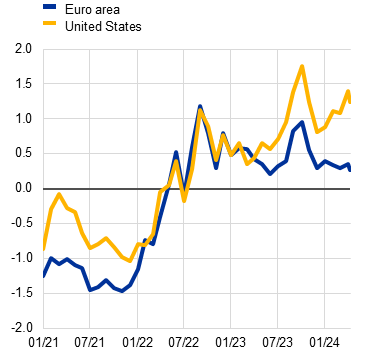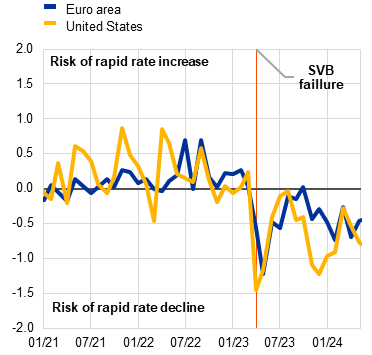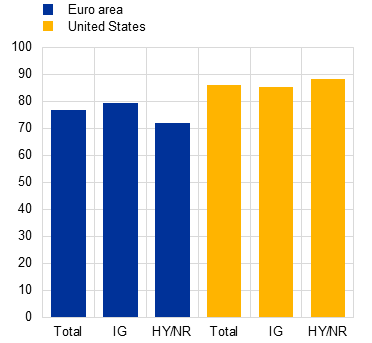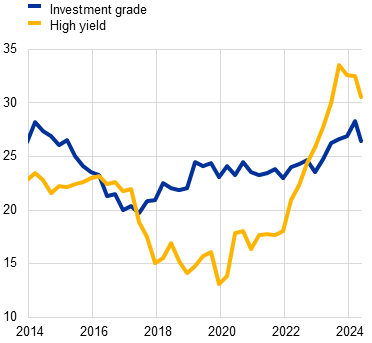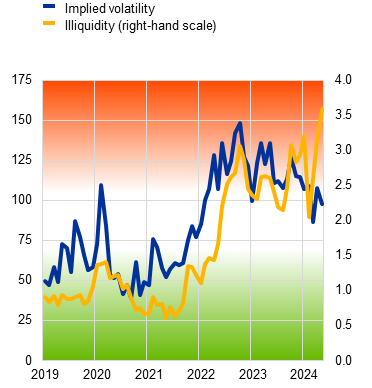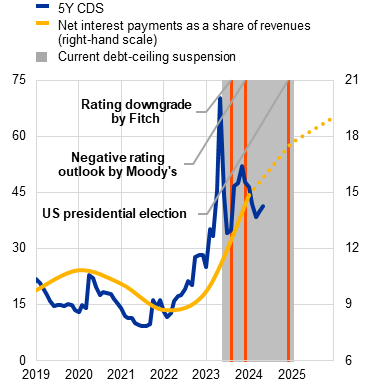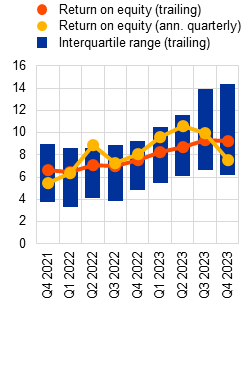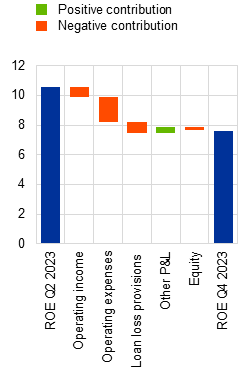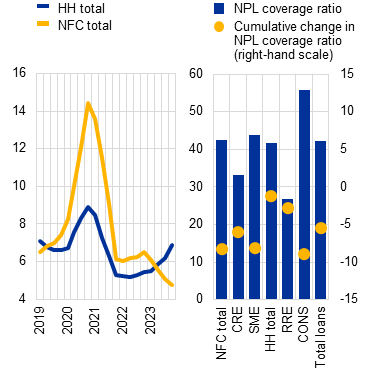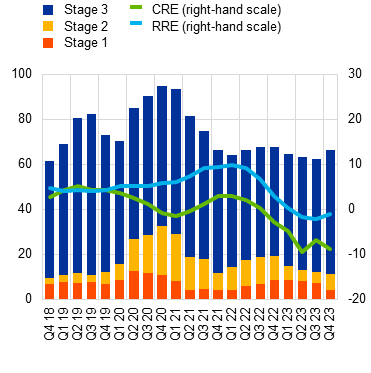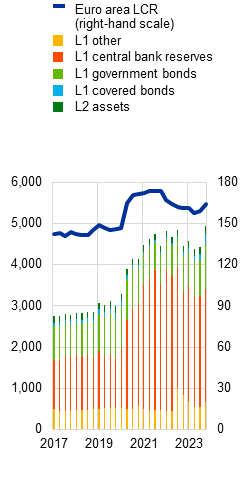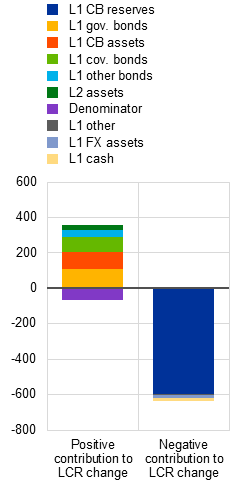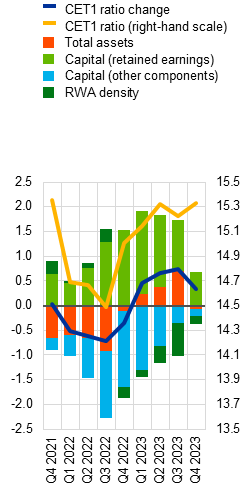
Readership survey
We would like to hear from readers of the Financial Stability Review. Your feedback will help shape the future of the publication.

Financial stability conditions have improved since the last edition of the Financial Stability Review was published. The near-term risk of a deep recession accompanied by rising unemployment – a major source of concern six months ago – is much lower from today’s perspective, and disinflation has proceeded in parallel.
At the same time, geopolitical tensions are a significant source of risk for not only euro area financial stability but also global financial stability. Policy uncertainty remains high around the world in a year featuring so many major elections. In such an environment, the scope for adverse economic and financial surprises is elevated, and the risk outlook for euro area financial stability remains fragile accordingly.
Financial markets have been looking through these risks, with risk premia and volatility remaining unusually compressed by historical standards. Yet sentiment can change rapidly, not least given the geopolitical environment and pricing-for-perfection which creates the potential for large market reactions to disappointing news.
While there are risks ahead, financial stability also depends on shock-absorbing capacity. So far, household and corporate balance sheets have proven resilient through this interest rate cycle, while euro area banks have withstood shocks well. This should not provide grounds for complacency, as pockets of vulnerability remain. Debt servicing capacities differ across corporates, with large real estate firms displaying greater vulnerability to rising interest rates. Lower-income households are finding it harder to service their debts, despite buoyant labour markets. At the same time, fiscal fundamentals remain vulnerable to negative growth surprises and fiscal slippage, as maturing debt is refinanced at higher interest rates. Parts of the non-bank financial intermediation sector, notably a cohort of open-ended investment funds, exhibit significant liquidity mismatches. At the same time, some non-bank entities may face risks related to relatively high leverage and portfolio concentration.
This issue of the Financial Stability Review (FSR) includes three special features. The first examines the implications of geopolitical risk for euro area financial stability. The second analyses the risks and benefits associated with the rise of artificial intelligence, while the third focuses on the growing footprint of private markets.
The FSR has been prepared with the involvement of the ESCB Financial Stability Committee, which assists the decision-making bodies of the ECB in the fulfilment of their tasks. The FSR promotes awareness of systemic risks among policymakers, the financial industry and the public at large, with the ultimate goal of promoting financial stability.
Luis de Guindos
Vice-President of the European Central Bank
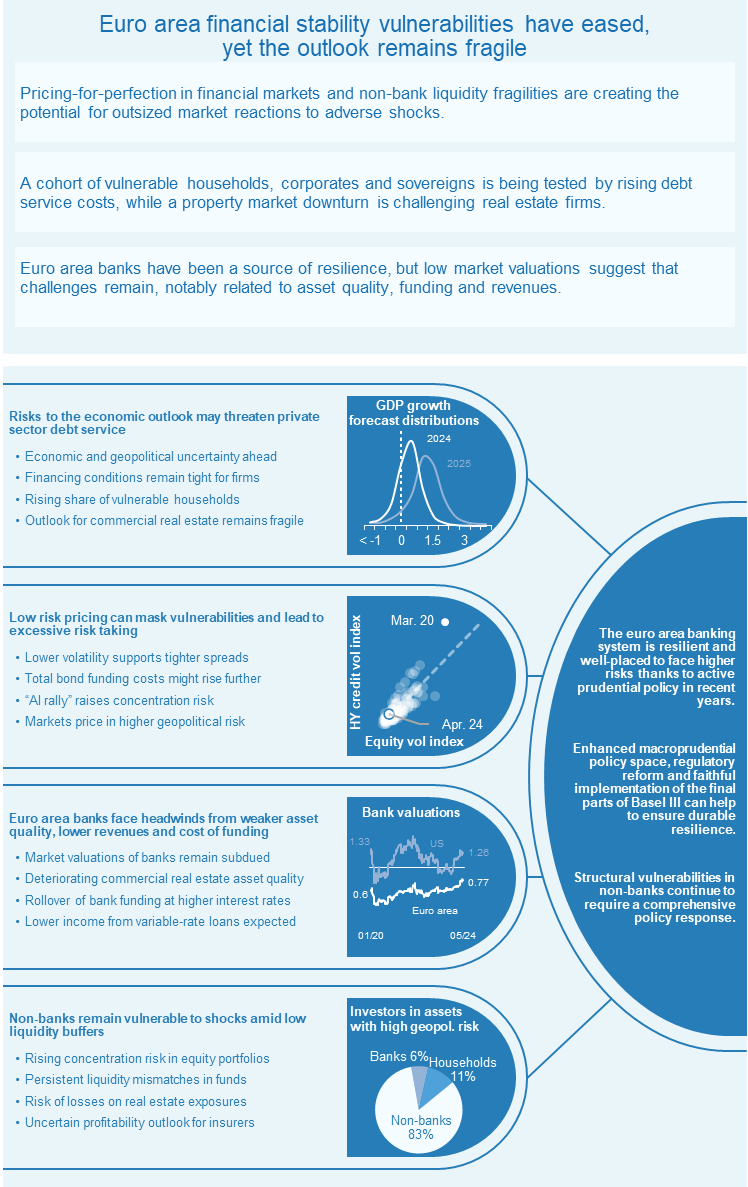
Euro area financial stability vulnerabilities have eased, yet the outlook remains fragile
Financial stability in the euro area has benefited from an improving economic outlook, but rising geopolitical risks could pose considerable downside risks. Favourable economic surprises in recent months have fostered investors’ baseline expectations that euro area inflation will reach the ECB’s target without a deep economic contraction, achieving a “soft-landing” scenario (Chart 1, panel a). Associated analyst expectations of interest rate cuts sparked a rally in financial markets, with growing signs of pricing-for-perfection creating the potential for outsized market reactions to disappointments. A key feature of post-pandemic balance sheet adjustment has been a fall in the debt ratios of euro area households, firms and sovereigns, which should bolster resilience in the medium to long term; however, some households, firms and sovereigns still have balance sheet vulnerabilities and could be challenged by rising debt service costs going forward. Euro area banks recorded strong profits in 2023 which, through the retention of earnings, helped to maintain resilience, but there are indications that the peak may have been reached. At the same time, the ongoing downturn in property markets, especially in commercial real estate, could have knock-on effects on the asset quality of some banks. Overall, despite reduced near-term recession risks and baseline expectations for an imminent return of moderate growth, risks to financial stability remain high. The likelihood of tail events materialising appears elevated as geopolitical risk has been on the rise (Chart 1, panel b). Should tensions ratchet up further, this could affect the supply of energy commodities, undermine confidence in the real economy, fuel inflation and spark risk aversion in financial markets (Special Feature A). Similarly, global economic policy uncertainty remains high, as countries with more than half of the world’s population are sending their citizens to the polls in 2024.
Against this backdrop, three key themes are shaping the outlook for euro area financial stability. First, benign risk pricing in financial markets and structural liquidity vulnerabilities in non-banks harbour the potential for sudden shifts in market sentiment in response to adverse shocks, triggered, for example, by negative macro-financial surprises or heightened geopolitical tensions. Second, rising debt service costs are challenging euro area households, firms and sovereigns with weak balance sheets, and the downturn in property markets is, in some cases, compounding household and corporate vulnerabilities. Third, euro area banks have remained resilient, supported by strong profitability. Bank earnings appear set to moderate somewhat from recent highs in the next two years. At the same time, bank market values, while having risen somewhat, remain stubbornly below book values − indicating deeper seeded investor concerns about the durability of bank profitability.
Chart 1
Positive macro surprises point to a soft landing, but tail risks remain elevated in the light of high macro-financial and geopolitical uncertainty
|
a) Citi Economic and Inflation Surprise Indices for the euro area and the United States |
b) Global policy uncertainty and geopolitical risk index |
|---|---|
|
(May 2023-Apr. 2024, indices) |
(Jan. 2004-Apr. 2024, indices) |
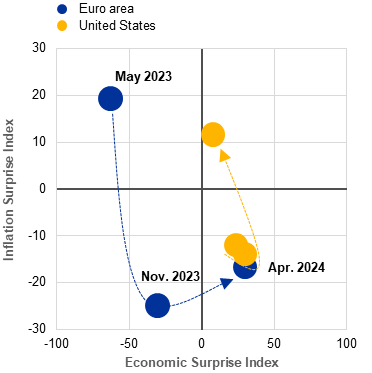 |
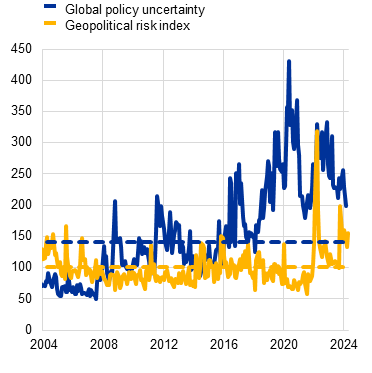 |
Sources: Bloomberg Finance L.P., Caldara and Iacoviello*, Baker, Bloom and Davis** and ECB calculations.
Notes: Panel b: the dashed lines represent the long-term averages over the period from January 1997 to April 2024. The global policy uncertainty index is shown until February 2024.
*) Caldara, D. and Iacoviello, M., “Measuring Geopolitical Risk”, American Economic Review, Vol. 112, No 4, April 2022, pp. 1194-1225.
**) Baker, S., Bloom, N. and Davis, S., “Measuring Economic Policy Uncertainty”, The Quarterly Journal of Economics, Vol. 131, No 4, November 2016, pp. 1593-1636.
Asset prices remain vulnerable to adverse dynamics that may be amplified by liquidity risks in non-banks
Expectations of monetary policy easing have boosted investor demand for risky assets, but risk sentiment in markets has been fickle. Expectations that monetary policy will ease around the world have been fuelling investors’ appetite for risky assets since October 2023, as markets have been pricing-in a soft landing for the global and euro area economies. Reflecting this, stock prices have increased and credit spreads have narrowed, with a short-lived reversal more recently (Chart 2, panel a). At the same time, equity market volatility has remained relatively subdued, despite the recent uptick and continued substantial uncertainty in both the macro-financial and geopolitical environments, and has diverged from volatility in interest rate markets, which has been elevated (Box 2). In this environment of substantial risks to growth and structurally higher funding costs, markets might underestimate and under-price the likelihood and the impact of adverse scenarios, which could cause vulnerabilities to build up. Moreover, there is a greater likelihood of negative surprises resulting in abrupt shifts in sentiment. Volatility in financial markets could increase significantly, should inflation deviate substantially from consensus expectations, if economic growth weakens or if geopolitical conflicts escalate further (Chart 2, panel b). Heightened concentration and high valuations in equity markets, notably in the United States, indicate scope for greater volatility and potential for a market correction. Given deeply integrated global equity markets, financial stability risks for the euro area might stem from adverse spillovers from the United States.
Chart 2
Geopolitical tensions may spark volatility and trigger adjustments in financial markets, which could be amplified by non-banks with low liquidity and high leverage
|
a) Global equity markets and high-yield corporate bond spreads |
b) Historical volatility distributions, by geopolitical risk regime |
c) Liquidity mismatch and leverage among euro area investment funds |
|---|---|---|
|
(1 Jan. 2021-7 May 2024; index, basis points) |
(3 Jan. 2000-7 May 2024, indices) |
(Q4 2023, ratios, bubble size: total assets, € trillions) |
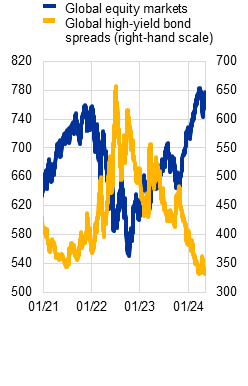 |
 |
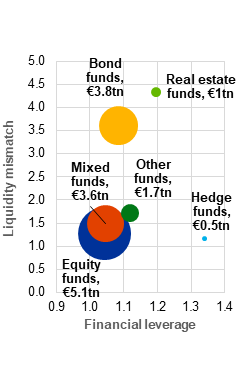 |
Sources: Bloomberg Finance L.P., Caldara and Iacoviello, ECB (IVF) and ECB calculations.
Notes: Panel a: the MSCI All Country World Index is used for global equity markets; the ICE BofA Global High Yield Index is used for global high-yield bond spreads. Panel b: VIX – index for implied volatility in the US equity market, MOVE – index for implied volatility in the US Treasury bond market. Geopolitical risk is measured by the geopolitical risk index (GPRI) created by Caldara and Iacoviello, op. cit. High geopolitical risk denotes episodes when the GPRI was at least 2 standard deviations above its average since 2000. Boxplots show the distributions of standardised volatility measures since 2000, where whiskers denote the 5th and 95th percentiles. Panel c: includes open-ended investment funds only. Liquidity mismatch is defined as the ratio of investment fund shares issued to liquid assets (deposits and debt securities with a maturity of less than one year, euro area sovereign bonds, investment and money market fund shares, and advanced economy listed shares). Financial leverage is defined as total assets divided by shares issued.
The non-bank financial intermediation sector could still amplify any market correction, given liquidity vulnerabilities, leveraged exposures and rising concentration risks. Non-banks have benefited from improving market conditions in recent months, supporting their portfolio valuations, while higher interest rates have also boosted investment income from debt securities. However, asset quality in non-bank portfolios may still be impaired by worsening corporate sector fundamentals and real estate market conditions together with rising geopolitical risk (Special Feature A). In this context, any shocks to market valuations could trigger a rise in investment fund outflows or margin calls on derivative exposures. Given low liquid asset holdings and significant liquidity mismatches in some types of open-ended investment funds, this could result in forced asset sales that may negatively affect wider financial stability (Chart 2, panel c). Although generally limited, pockets of elevated financial and synthetic leverage in some entities may add to spillover risks. In addition, concentration in equity portfolios − notably in investment funds due to exposures to US-based technology firms − has increased markedly in recent years (Chapter 4), making investment portfolios more vulnerable to idiosyncratic shocks or adverse developments in the US economy. For the insurance sector, uncertainties around a weak macro-financial outlook highlight possible profitability headwinds. These include both underwriting profitability challenges for life insurers and consistently low returns on debt securities portfolios.
Tight financial conditions are testing the resilience of vulnerable households, firms and sovereigns
Euro area households, firms and sovereigns have so far remained resilient on aggregate, albeit with some pockets of vulnerability. The indebtedness of euro area households, firms and sovereigns has declined from post-pandemic highs (Chart 3, panel a), alleviating debt sustainability concerns. However, associated vulnerabilities remain elevated, especially among sovereigns. Here indebtedness remains above pre-pandemic levels, owing partly to a transfer of risk from the private sector to sovereign balance sheets during the pandemic as well as during the recent energy crisis and period of high inflation. The debt service costs of non-financial sectors are likely to remain at current high levels or even creep up further as the debt originally contracted at historically low interest rates and at long maturities continues to reprice at prevailing, significantly higher, interest rates. This means that a vulnerable cohort of highly indebted households, firms and sovereigns may still see their debt servicing capabilities challenged going forward.
Sovereign financing conditions have improved, but fiscal fundamentals remain vulnerable to negative growth surprises and fiscal slippage. Sovereign borrowing costs have benefited from easier financing conditions of late and positive rating actions in some countries (Chart 3, panel b). Interest costs are set to rise further, however, especially for sovereigns with high short-term refinancing needs, as maturing public debt is rolled over at higher interest rates. Despite falling debt-to-GDP ratios in recent years, fiscal fundamentals remain fragile in a number of countries, as indicated by missed deficit targets in some cases in 2023. Given structural headwinds to potential growth from factors such as weak productivity, persistently elevated debt levels and budget deficits would be more likely to reignite debt sustainability concerns and push sovereign credit risk premia higher in the event of adverse macro-financial surprises. Risks of fiscal slippage in the light of a busy electoral agenda in 2024-25 (at both national and EU levels) or uncertainties around the exact implementation of the new EU fiscal framework could lead market participants to reprice sovereign risk. On the other hand, greater fiscal reform to ensure that public finances have a more growth-friendly composition could enhance the medium-term economic growth potential of the euro area, thereby mitigating debt sustainability risks.
Chart 3
Debt levels in the non-financial sectors have fallen from pandemic highs, but debt service costs may still rise further
|
a) Household, NFC and sovereign indebtedness |
b) Ten-year government bond yields and credit ratings of euro area sovereigns |
c) Lending rates to the euro area non-financial private sector |
|---|---|---|
|
(percentages of GDP) |
(percentages, rating buckets) |
(Jan. 2015-Mar. 2024, percentages) |
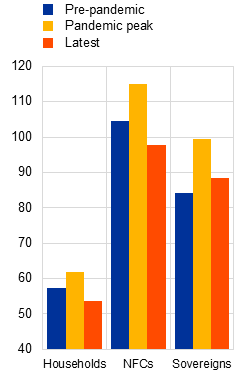 |
 |
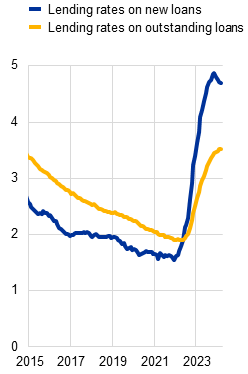 |
Sources: Bloomberg Finance L.P., LSEG, S&P Global Market Intelligence, Moody’s Analytics, Fitch Ratings, Eurostat and ECB (QSA), ECB (MIR) and ECB calculations.
Notes: Panel a: NFCs stands for non-financial corporations. NFC debt is illustrated in unconsolidated terms, i.e. including intra-sectoral loans. “Pre-pandemic” indicates figures as at Q4 2019, “Pandemic peak” refers to Q1 2021, and the latest observation captures Q4 2023. Panel b: ratings and rating outlooks are aggregated from S&P, Moody’s and Fitch and are shown as at 31 October 2023 and 30 April 2024. Rating outlooks are only indicated for those sovereigns for which the aggregated outlook has changed since October 2023. Aggregated outlooks can be determined by the outlook from a single agency; for instance, two stable outlooks and one negative outlook, which was the case for Italy in October 2023, are aggregated to form an overall negative outlook.
Euro area household and corporate balance sheets have been bolstered by a resilient labour market and strong post-pandemic profits. Corporate profitability has continued to hold up relatively well, supporting firms’ debt servicing capacity (Section 1.3). Declining energy and other input costs have boosted corporate earnings despite weak consumer demand, although the impact of anaemic growth and higher labour costs on profit margins might not have fully materialised yet. While corporate insolvencies have continued rising to above pre-pandemic levels in a number of euro area countries, defaults and non-performing loan rates have remained relatively low. At the same time, euro area household vulnerabilities have been mitigated by the resilience of labour markets, coupled with government support measures and excess savings accumulated during the pandemic. While household and corporate debt-to-GDP levels have dropped below pre-pandemic readings, the pass-through of higher interest rates to debt service costs is incomplete. Continued loan repricing at higher market rates than on outstanding loans (Chart 3, panel c), together with weaker than expected growth and deteriorating labour market conditions, could erode household and corporate debt servicing capacity. At the same time, evaporating liquidity buffers (Chart 4, panel a) may render households and firms vulnerable to unexpected adverse shocks.
Pockets of vulnerability remain, as high interest rates weigh on the debt servicing capacity of vulnerable households and firms. High debt service costs could prove especially challenging for firms with lower credit ratings, as reflected by the rise in expected default frequencies in the high-yield segment. Expected default rates are also highly uneven across economic sectors, with firms operating in wholesale trade or in real estate seeing some of the largest increases in expected default rates (Chart 4, panel b). Defaults could rise if yields remain high, energy prices soar again or global supply chain disruptions intensify. Euro area households, especially those with lower incomes and in countries with mainly floating-rate mortgage lending, are being relatively more challenged by higher interest rates (Chart 4, panel c). However, middle-income households may be affected too, especially if labour market conditions were to weaken considerably. In such a scenario the implications for banks mortgage portfolios could become notable.
Chart 4
Declining liquidity buffers of euro area households and firms in recent years may weigh on the debt servicing capabilities of vulnerable cohorts
|
a) Cash and deposit holdings of euro area households and NFCs |
b) One-year default rate forecasts in Europe, by industry |
c) Household expectations of payment difficulties in the next three months, by income |
|---|---|---|
|
(Q1 2016-Q4 2023, percentages of GDP) |
(June 2022, Mar. 2024, percentages) |
(Q1 2021-Q1 2024, percentages of consumers) |
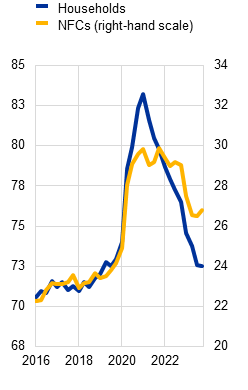 |
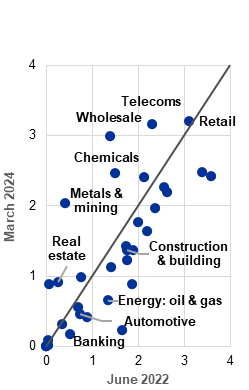 |
 |
Sources: Eurostat and ECB (QSA), ECB (CES), Moody’s Analytics and ECB calculations.
Notes: Panel b: June 2022 is the month before the start of the recent monetary policy hiking cycle. Panel c: the share of consumers is calculated using survey weights, and the total number of surveyed households includes those who report not having a loan or answering “don’t know”. The sample of countries comprises Belgium, Germany, Spain, France, Italy and the Netherlands, and from April 2022 also includes Ireland, Greece, Austria, Portugal and Finland. The share of lower-income households is calculated as the average of the first and second income quintiles, middle-income households correspond to the third income quintile, and higher-income households comprise the average of the fourth and fifth income quintiles. The total shares are equal-weighted averages of the shares for mortgages and other loans.
Tight financial conditions have underscored vulnerabilities in real estate markets, compounding the challenges faced by some households and firms. The sharp downturn in the commercial real estate (CRE) sector has continued (Chart 5, panel a), with subdued market activity continuing to hamper price discovery. Prices could decline further, given structurally lower demand for some CRE assets post-pandemic, notably in the office segment (Section 1.5). Sharp drops in rental income and profit margins since early 2022 have made real estate firms particularly vulnerable to losses, compounding the challenges posed by refinancing debt at higher rates (Box 1). The ongoing adjustment in residential real estate (RRE) markets has remained orderly, as households’ financial positions have been underpinned by the strength of the labour market. There have also been signs of incipient stabilisation of euro area house prices at the aggregate level, but risks remain tilted to the downside, especially in countries with elevated debt levels and overvalued property markets. That said, the expected decline in borrowing costs might alleviate affordability challenges and boost loan demand going forward. Overall, the downturn in the RRE market should remain orderly, unless labour market conditions deteriorate significantly.
Banks remained resilient, but face headwinds from weaker asset quality, lower revenues and cost of funding
There are signs of deterioration in the asset quality of euro area banks, notably in CRE portfolios. While banks’ non-performing loan ratios remained at historically low levels just above 2% in 2023, there have been nascent signs of rising losses on a subset of loan portfolios that are more sensitive to cyclical downturns. In fact, CRE loan books have been the main driver of asset quality deterioration, reflecting both the downturn in euro area CRE markets and spillovers from the ongoing correction in US CRE markets to euro area banks with material exposures. That said, these portfolios are generally modest in size and should not have a systemic impact on the banking sector. For some banks with above-average CRE exposure, though, a marked deterioration in CRE asset quality could pose challenges. At the same time, the credit risk outlook for household and corporate portfolios remains tilted to the downside, as macro-financial conditions are weak and borrowers are increasingly feeling the impact of higher interest rates. As a result, banks may face the risk of higher provisioning costs if risks in the non-financial sectors materialise, not least because collateral values may not to be fully reflected in banks’ balance sheets.
Euro area banks continue to face funding cost headwinds. Since the previous issue of the Financial Stability Review was published, bank bond yields have declined and new business deposit rates have lost upward momentum in line with market expectations of looming policy rate cuts (Chart 5, panel b). However, the average cost of outstanding bank funding has risen further, reflecting a shift in composition towards more expensive sources of funding. In particular, depositors seeking higher remuneration have been shifting from overnight deposits to higher-yielding term deposits. At the same time, bond funding has also been growing as it replaces other sources such as the ECB’s targeted longer-term refinancing operations (TLTROs). Looking ahead, bank funding costs seem set to remain high as maturing liabilities reprice at higher levels and the composition of funding continues moving back towards long-run averages featuring a higher share of term deposits and bonds. Overall funding costs might therefore still increase further, even if policy rates start to decline.
Low bank valuations indicate market concerns regarding the longer-term sustainability of bank profits. In recent years, strong euro area bank profitability has primarily been driven by rising net interest margins. This is because bank funding costs adjusted more slowly than lending rates due to the automatic repricing of floating-rate loans. As such, floating-rate assets could now turn into a headwind for banks’ interest income as policy rates are expected to fall, while overall funding costs may increase still further. Indeed, the recent decrease in interest rate spreads suggests that euro area banks are likely to see their net interest margins decline (Chart 5, panel c). Margin compression, together with continued muted lending volumes, could serve to reduce banks’ operating income and compound the challenges stemming from deteriorating asset quality, ultimately weighing on bank profitability. These profitability uncertainties are also visible in euro area bank price-to-book valuations, which have continued to hover around 0.7 (Chapter 3), well below those of some major international peers.
Chart 5
Euro area bank profitability has likely peaked, with signs of worsening asset quality and higher funding costs posing headwinds to euro area banks going forward
|
a) CRE values, RRE prices and net NPL inflows across euro area countries |
b) Bank funding costs on new funding, by type of funding source |
c) Euro area banks’ net interest rate spread and margin |
|---|---|---|
|
(Q4 2023, annual percentage changes) |
(Jan. 2016-Mar. 2024, percentages) |
(Jan. 2016-Mar. 2024; percentage points, percentages) |
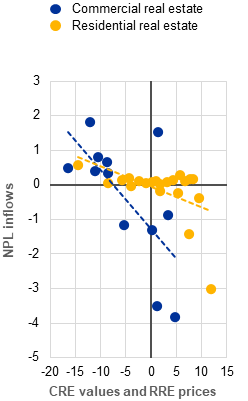 |
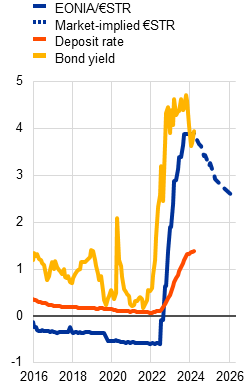 |
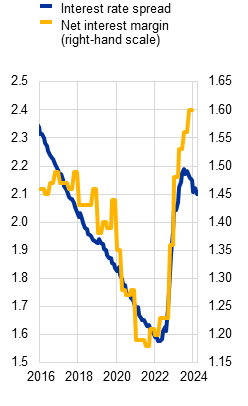 |
Sources: Bloomberg Finance L.P., Dealogic, Eurostat and ECB (RESR), ECB (MIR, RESC, supervisory data) and ECB calculations.
Notes: Panel a: NPL stands for non-performing loan. Panel b: market implied €STR is shown for April 2024 until March 2026. Panel c: net interest margin is shown until the fourth quarter of 2023.
From a structural perspective, a greater need to respond to cyber and climate risks, and strong interlinkages with the non-bank financial intermediation (NBFI) sector, may also challenge euro area banks. Next to the headwinds associated with challenging macro-financial conditions that lie ahead, euro area banks need to press ahead with digital transformation, not least so that they can respond to the growing threat of cyber risks as well as address the opportunities and challenges associated with the rise of artificial intelligence (Special Feature B). Euro area banks also need to carefully manage the implications of the transition to a greener economy. In addition, elevated vulnerabilities in the NBFI sector may produce spillover risks for euro area banks, given strong interconnections between these sub-sectors of the financial system, not least via the funding channel (Box 4).
Macroprudential policies can help safeguard and strengthen resilience across the financial system
All in all, financial stability vulnerabilities have eased, but the outlook remains fragile. Financial stability conditions have improved somewhat since the previous issue of the Financial Stability Review was published. This includes some positive economic surprises and faster than expected disinflation, underpinning expectations in financial markets of a soft landing. That said, despite improved baseline expectations, the likelihood of tail events appears elevated. In particular, the materialisation of downside risks to economic growth, more persistent inflation outturns or acute geopolitical stress could expose existing vulnerabilities. This would notably concern risks associated with the potential for disorderly adjustments in financial markets, coupled with debt servicing challenges for highly indebted households, firms and sovereigns and their adverse knock-on effects on the asset quality of euro area banks.
Preserving the resilience of the banking sector and, where conditions are favourable, further increasing macroprudential space remain crucial in an uncertain macro-financial environment. The resilience of the euro area banking sector is, on aggregate, underpinned by strong capital and liquidity positions. Standard regulatory metrics point towards strong liquidity resilience overall, despite more than 90% of borrowed TLTRO funds being repaid over recent quarters. On aggregate, solvency ratios remain robust, supported by organic growth from high bank profitability. In recent years, euro area macroprudential authorities have also implemented a comprehensive set of measures that have bolstered banks’ resilience and enhanced the availability of releasable capital buffers. As such, it is prudent to maintain macroprudential capital buffers to ensure that they remain available in case of headwinds. Prevailing borrower-based measures can continue to act as structural backstops to ensure sound lending standards in a framework where capital-based and borrower-based measures complement each other. The recent strength of profitability of the banking sector can be used to further increase macroprudential space through releasable capital buffers, to further strengthen the resilience of bank lending to the economy in the event of marked economic downturns.
Structural vulnerabilities in the NBFI sector require a comprehensive policy response to enhance its resilience from a macroprudential perspective. A large market footprint and the interconnectedness of non-bank financial institutions call for a comprehensive set of policy measures to increase the sector’s resilience. This includes policies aimed at enhancing the liquidity preparedness of non-bank market participants to meet margin and collateral calls (Box 5), tackling risks from non-bank leverage (Box 6), mitigating liquidity mismatch in open-ended funds and enhancing the resilience of money market funds to liquidity shocks (Section 5.2). A more integrated EU-wide system of supervision for non-banks would also build a level playing field and reduce the potential for regulatory arbitrage. A resilient NBFI sector would also help to foster more integrated capital markets, which could enhance financial stability and complement the objectives of the capital markets union.
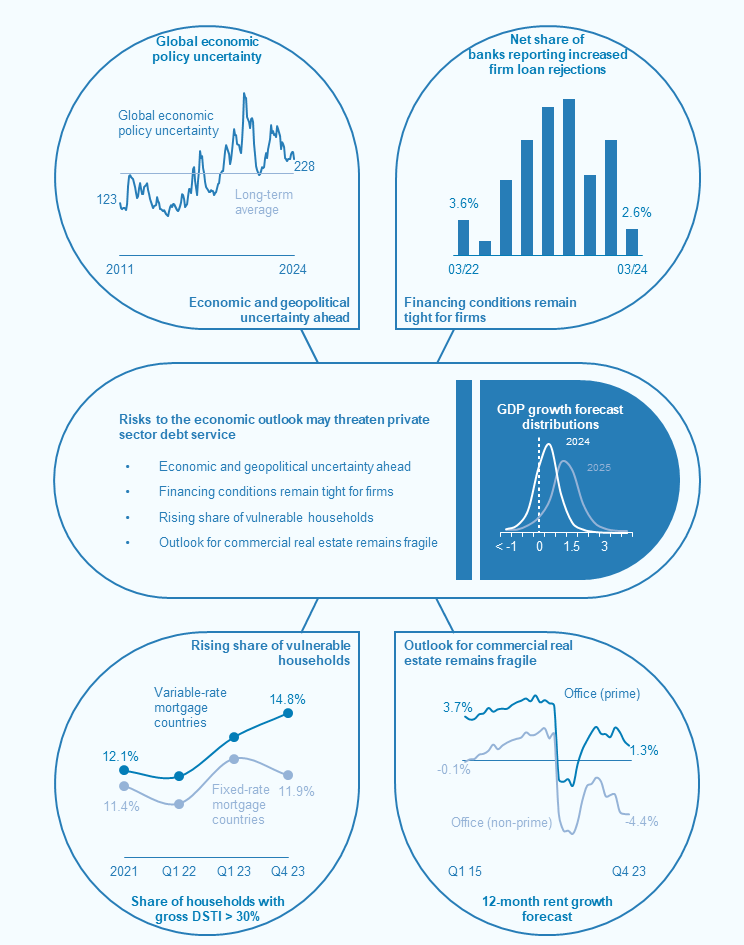
1.1 While risks of a deep recession have declined, geopolitical risks are on the rise
Investor sentiment has been recovering alongside an improving macro-financial outlook, although prospects for growth vary across euro area countries. Headline inflation in the euro area is now projected to fall to 2.3% in 2024, compared with 2.7% expected just six months ago. In parallel, although economic growth in 2024 is likely to be weaker than previously hoped, there is less likelihood of the euro area experiencing a severe downturn. Taken together, this has improved near-term investor sentiment. Looking ahead, the financial stability outlook will increasingly depend on mixed medium-term growth prospects. On the one hand, economic activity is expected to pick up more strongly over the period 2025-26 (Chart 1.1, panel a), supported by resilient labour markets and a recovery in households’ real incomes. On the other hand, structural challenges (related to, for example, slow digitalisation, weak innovation and an ageing population) remain a drag on productivity and income growth. Finally, current growth expectations vary considerably across the euro area (Chart 1.1, panel b), making some countries more vulnerable to future adverse shocks than others.
Chart 1.1
The near-term economic outlook is improving unevenly across countries, while medium-term growth challenges remain
|
a) Economic growth outlook in the euro area |
b) Distribution of real GDP growth forecasts across euro area countries for 2024 and 2025 |
|---|---|
|
(2018-26; index, 2018 = 100) |
(Apr. 2024, percentages) |
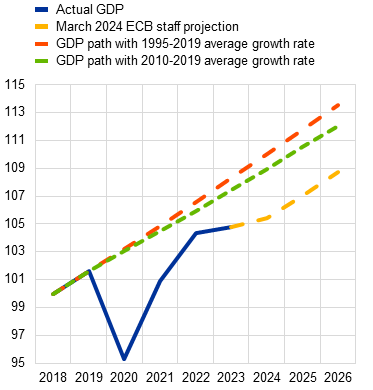 |
 |
Sources: ECB staff macroeconomic projections for the euro area, March 2024, Consensus Economics Inc. and ECB calculations.
Notes: Panel a: alternative post-2019 GDP paths use different assumptions about annual GDP growth rates. Panel b: the cross-country distributions of GDP growth forecasts are based on average country forecasts made by professional forecasters in April 2024 for Belgium, Germany, Ireland, Greece, Spain, France, Italy, the Netherlands, Austria, Portugal and Finland.
Risks to the macro-financial outlook remain elevated. Several such risks are related to external factors. Global demand could surprise to the downside if tight financing conditions continue to squeeze incomes and expenditure more strongly than expected, or if higher than expected inflation in the United States leads to a delayed easing of US monetary policy spilling over to tighter financing conditions globally. Divergent policy paths between the United States and the euro area would in turn increase the risk of adverse spillovers to European financial markets (Chart 1.2, panel a). Demand for euro area exports could be further weakened if the ongoing adjustment in property markets in China has a more pronounced, negative impact on its broader economy. As some euro area economies with relatively weaker near-term growth prospects depend heavily on exports to China, this would further amplify divergence between growth outcomes in the euro area. While progress has been made in bringing euro area inflation down, domestic price pressures are still high, owing in part to strong wage growth which could still surprise to the upside given how tight labour markets are. Globally diverging monetary policy paths could also lead to higher inflation via their impact on the euro exchange rate and import prices.[1] Finally, geopolitical tensions could, as a result of their impact on commodity prices and global supply chains, lead to renewed inflationary pressures in the euro area as well.
Chart 1.2
Elevated external risks cloud the macroeconomic outlook for the euro area
|
a) Evolution of economic growth forecasts for 2024 |
b) Container shipping costs and global supply chain pressures |
c) New trade restrictions around the world, by year of introduction |
|---|---|---|
|
(Jan. 2023-Apr. 2024, percentages) |
(Jan. 2018-Apr. 2024; index, USD) |
(2014-May 2024, number of measures) |
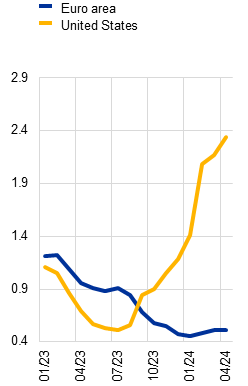 |
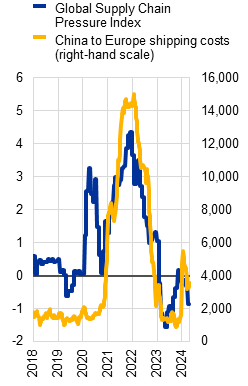 |
 |
Sources: Consensus Economics Inc., Bloomberg Finance L.P., Federal Reserve Bank of New York (AMEC), Global Trade Alert and ECB calculations.
Notes: Panel a: average GDP growth forecasts among professional forecasters. Panel b: higher values for the Global Supply Chain Pressure Index represent greater pressures on supply chains. Panel c: all measures introduced globally that restrict cross-border flows of goods, services and foreign direct investment. Data for 2024 are as of 7 May 2024.
Geopolitical tensions have risen, posing risks to the global growth outlook and the euro area disinflation process. Russia’s war against Ukraine and the conflict in the Middle East are key sources of tail risk. The recent attacks on cargo ships on the Red Sea trade route triggered an abrupt rise in shipping costs between Asia and Europe in December 2023 (Chart 1.2, panel b) and global supply chain pressures have been on the rise since last autumn. The immediate risks to inflation and growth in the euro area from the Red Sea attacks seem limited owing to their minimal impact on oil production costs, current spare capacity in global shipping and subdued global demand. However, the impact on euro area growth and inflation could be substantial if the disruptions were to escalate to the broader region and last longer. The recent intensification of the Iran-Israel conflict has increased the probability of such a tail-risk scenario materialising. The expected reduction in oil production by its main exporters, as well as supply disruptions to oil and gas facilities in Russia and Ukraine, pose further upside risks to oil and gas prices. The rise in geopolitical tensions between major economies in recent years is also leading to weakening global trade links. For example, the share of imports to the United States from China declined from 25% in 2017 to 15% in 2023, and the number of protectionist measures targeting cross-border trade is increasing globally (Chart 1.2, panel c). Continued geopolitical tensions pose the risk of economic and financial fragmentation in the world economy, with potential adverse effects on financial stability in the euro area and globally. These potential effects could include slower productivity growth and higher production costs resulting from less efficient resource allocation, greater macro-financial volatility due to reduced international risk-sharing opportunities, and lower profitability and a higher cost of funding for financial institutions on the back of reduced cross-border capital flows. In this context, the record number of elections due to take place across the world in 2024 are likely to keep the uncertainty around global economic policies elevated.
1.2 Lax fiscal policies may reinforce public debt sustainability concerns
While sovereign financing conditions have improved, borrowing needs are high and could be tested by rising geopolitical tensions and other risks. Euro area sovereigns have benefited from easier global financing conditions in recent months, and demand for sovereign debt has been strong as investors try to lock in higher yields before the expected cuts in central bank interest rates materialise (Chart 1.3, panel a). Spreads between lower- and higher-rated sovereigns have also declined (Chart 3, panel b in the Overview), reflecting favourable risk sentiment, as well as better prospects for growth in lower-rated countries and declining debt-to-GDP ratios. Nevertheless, since yields on new sovereign issuances are still above average yields on outstanding debt, sovereign interest burdens are continuing to rise. This could lead to greater challenges ahead, particularly for countries with greater short-term financing needs. Any reassessment of sovereign risk by market participants due to high debt levels and lenient fiscal policies could raise borrowing costs further and have negative financial stability effects, including via spillovers to private borrowers and to sovereign bond holders. Finally, rising geopolitical tensions and upcoming elections in many countries are increasing uncertainty around future borrowing needs.
Chart 1.3
Sovereign debt issuance is currently benefiting from strong investor demand, but projected large financing needs leave sovereigns vulnerable to adverse shocks
|
a) Cumulative sovereign debt issuance in the euro area, by maturity at origination |
b) Past and projected structural primary balances across euro area countries |
|---|---|
|
(Jan. 2020-Mar. 2024; € billions, years) |
(2016-19 and projections for 2024-25, percentages of GDP) |
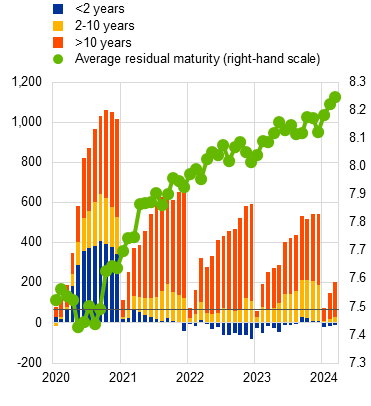 |
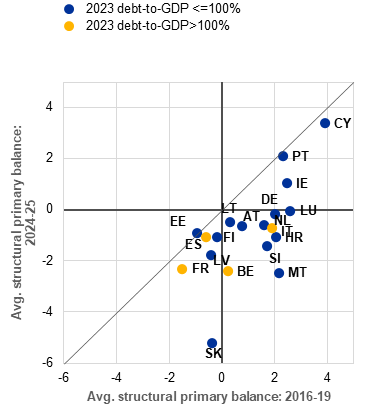 |
Sources: Eurostat and ECB (GFS), European Commission (AMECO) and ECB calculations.
Notes: Panel a: the bars in the chart show cumulative debt issuance since the start of the calendar year. Panel b: for Greece (not shown), the average structural primary balance was 8.7% of GDP in the period 2016-19 and is expected to average 1.9% of GDP in the period 2024-25.
National budget deficits are expected to stay larger than they were before the pandemic as many of the support measures taken have remained in place. While most of the energy and inflation support measures introduced after the Russian invasion of Ukraine are being phased out, many of the measures taken during the pandemic have not been fully rolled back. Moreover, structural primary balances (i.e. budget balances adjusted for the impact of changes in economic growth due to business cycle fluctuations and excluding interest payments on outstanding debt) are expected to remain well below pre-pandemic levels over 2024-25. This is the case for almost all euro area countries, irrespective of their starting level of sovereign debt (Chart 1.3, panel b). Potential fiscal slippages are an additional concern, as weakening economic activity has already contributed to some countries missing deficit targets in 2023, and the upcoming cycle of elections is increasing the risk of fiscal targets being missed as well. The lack of envisaged fiscal consolidation, combined with high debt levels, makes national budgets vulnerable to intensifying geopolitical tensions should these require increases in spending on defence, for example. It would also be more difficult to accommodate additional investment in areas such as climate change and digital technology, which would have a negative effect on euro area growth potential.
Chart 1.4
Despite falling somewhat in recent years, projected sovereign debt levels remain high
|
a) Change in euro area government debt-to-GDP and its drivers |
b) Projected government debt-to-GDP ratios across euro area countries |
|---|---|
|
(2021-25, percentages of GDP and percentage point contributions) |
(2019 and 2025, percentages of GDP) |
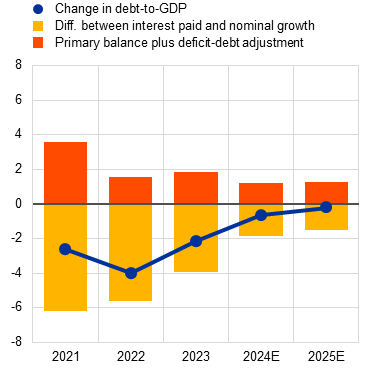 |
 |
Sources: European Commission (AMECO), Eurostat and ECB (GFS) and ECB calculations.
Note: Panel a: values for 2024 and 2025 are projections.
High levels of debt make euro area sovereigns vulnerable to adverse shocks, especially given the structural weakness in productivity and potential growth. While the government debt-to-GDP ratio in the euro area has fallen gradually from its pandemic-era peaks, the drop has been primarily driven by the post-pandemic recovery in nominal GDP, which has more than offset the impact of higher debt service costs on debt levels (Chart 1.4, panel a). With weaker nominal growth prospects ahead and little change expected in the structural primary balances, the debt-to-GDP ratio is falling at a slower pace. As a result, public debt levels in most euro area countries are expected to remain above pre-pandemic levels in the short to medium term (Chart 1.4, panel b). More importantly, structural headwinds to potential growth, from weak productivity for instance, are raising concerns about longer-term debt sustainability, making sovereign finances more vulnerable to adverse shocks and elevating risks to the financial stability outlook.
1.3 Euro area firms are coping with rising debt service costs
Resilient post-pandemic profitability has helped firms to service the rising cost of debt, but weak growth and high labour costs are creating challenges. The interest payments faced by non-financial corporations (NFCs) have risen further in recent quarters (Chart 1.5, panel a) and are expected to remain close to their current levels or even increase for some corporates in the near future, even if the cost of new borrowing continues to decline. This is because a large share of firms still need to refinance loans and bonds that were originated at low interest rates, before the recent surge in borrowing costs. For example, at the end of 2021, around 25% of firms’ bank loans had interest rates fixed for between two and five years. Firms’ debt repayment capacity has held up relatively well so far, supported by the strong revenue growth seen in recent years (Box 1). At the same time, however, firms’ profitability is weakening and is expected to decline further in 2024, owing to the poor outlook for growth for 2024 (Chart 1.5, panel b) and the fact that labour costs are still growing strongly. Since access to external funding could remain constrained by tight bank lending standards for a longer period of time (Chapter 3), a significant and protracted slowdown in earnings growth would make debt repayments much more difficult to meet, especially for firms that have already drawn on their cash buffers.
Chart 1.5
If profitability weakens, firms’ ability to accommodate rising debt service costs could be challenged, especially in sectors most sensitive to changes in interest rates
|
a) Interest payments and net entrepreneurial income growth |
b) Expected growth in the nominal earnings of listed euro area companies |
c) Median interest coverage ratio and cash buffers in selected sectors |
|---|---|---|
|
(Q1 2005-Q4 2023; percentages, year-on-year percentage point changes) |
(2 June 2023-26 Apr. 2024, year-on year percentage point changes) |
(Q4 2019 vs Q4 2023, percentages) |
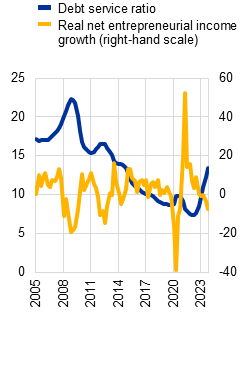 |
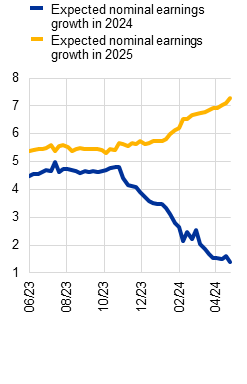 |
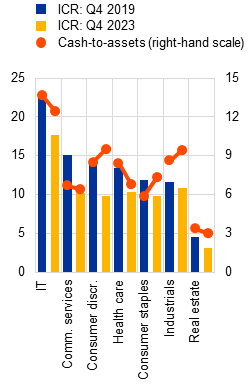 |
Sources: Eurostat and ECB (MNA, QSA), LSEG, S&P Global Market Intelligence and ECB calculations.
Notes: Panel a: the debt service ratio is the sum of the interest paid in the current and the past three quarters divided by the sum of net operating surplus and property income in the current and the past three quarters for the NFC sector. Net entrepreneurial income is the sum of gross operating surplus and property income net of depreciation. Panel b: analysts’ forecasts for nominal earnings growth for 2024 and 2025 are calculated for the companies included in the MSCI EMU index. Panel c: the cash-to-assets ratio is defined as cash plus cash equivalents over total assets. ICR stands for interest coverage ratio and is defined as the ratio of earnings before interest, taxes, depreciation and amortisation (EBITDA) to interest expense. Firm-level ICR and the cash-to-assets ratio are computed as four-quarter moving averages. “Comm. services” stands for communication services; “Consumer discr.” stands for consumer discretionary goods.
Vulnerabilities are elevated, particularly in those sectors and countries most exposed to the impact of higher interest rates. While the overall debt servicing capacity of euro area firms has been resilient, tight financing conditions have had a bigger impact on some countries and sectors than on others. Among large firms, the ability to meet interest payments from earnings has declined substantially since the end of 2019 in those sectors, such as real estate and discretionary consumer goods, affected by weaker demand on the back of higher interest rates on consumer and mortgage loans (Chart 1.5, panel c). Firms in the real estate sector have seen particularly large declines in their profitability since mid-2022, making them highly vulnerable to continuing tight financing conditions and to downside risks to the growth outlook (Section 1.5). Default rates on bank loans to commercial real estate firms are rising (albeit from low levels), reflecting eroding financial health. The same also applies to loans to small and medium-sized enterprises, since they have smaller liquidity buffers and lower profit margins than bigger firms (Chapter 3). Finally, corporate interest burdens have also increased more strongly in euro area countries where floating-rate lending is prevalent than in countries with a larger share of fixed-rate loans (Box 1). At the same time, if downside risks do not materialise, NFCs with floating-rate loans will also benefit more quickly from the expected declines in market rates than borrowers with fixed-rate loans.
Chart 1.6
Subdued borrowing is contributing to declining indebtedness of euro area corporates
|
a) NFC financing flows and demand for bank loans |
b) Change in corporate indebtedness since Q2 2022, by country |
|---|---|
|
(Q1 2018-Q1 2024; € billions, index) |
(Q2 2022 vs Q4 2023, percentages) |
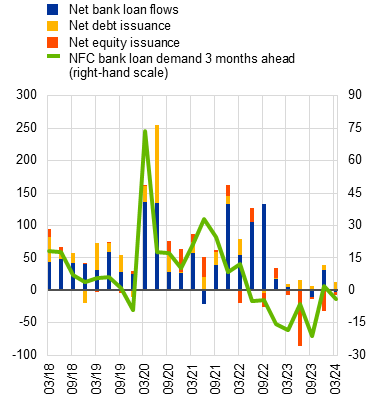 |
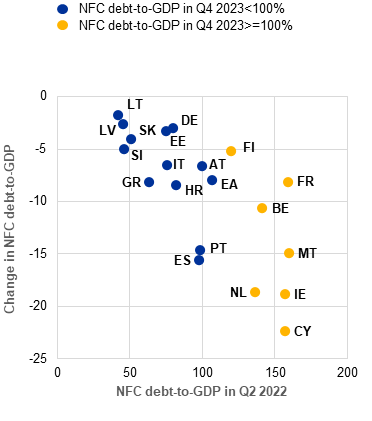 |
Sources: ECB (BLS, BSI, CSEC), Eurostat and ECB (QSA) and ECB calculations.
Notes: Panel a: the “bank loan demand” indicator reflects changes anticipated by banks. It is equal to the difference between the sum of the shares of banks responding that demand for corporate loans is expected to “increase considerably” and “increase somewhat” and the sum of the shares of banks responding that demand for corporate loans is expected to “decrease somewhat” and “decrease considerably”. Panel b: the chart shows the ratio of the gross non-consolidated debt (i.e. including intra-sectoral loans) of NFCs to GDP. Changes in the gross NFC debt-to-GDP ratio are calculated for the period Q2 2022-Q4 2023. The chart does not show Luxembourg, where the gross NFC debt-to-GDP ratio increased from 315.5% in Q2 2022 to 316.8% in Q4 2023. The non-consolidated NFC debt levels for Cyprus include the debt held by special-purpose entities.
Lending standards are expected to remain tight for some time, which could create additional headwinds for firms with high near-term refinancing needs. New borrowing by firms has remained subdued across all borrowing instruments in recent months (Chart 1.6, panel a), particularly for small and newly established firms. To a certain extent, this weakness reflects low demand for external financing because of high borrowing costs and an uncertain business outlook, as well as tight credit standards imposed by lenders. While the cost of new credit has been falling recently as lenders start to price-in the expected decline in central bank interest rates, it remains historically high, with the average interest rate on new bank loans to corporates at above 5% since September 2023. With the outlook for near-term growth subdued and lending standards expected to remain tight going forward, the near-term outlook for corporate borrowing is weak. This could pose a risk to firms’ debt rollover capacity, especially if growth continues to surprise to the downside and if the downward pressure on corporate profitability reduces firms’ capacity to substitute external with internal funding.
The ongoing corporate deleveraging should support firms’ access to external financing once the economy picks up and financing conditions ease. Weak new borrowing since late 2022 and the negative effect of past high inflation on corporate debt ratios have contributed to considerable deleveraging among firms, with the aggregate NFC gross-debt-to-GDP ratio in the euro area declining from 106.4% in the second quarter of 2022 to 98.4% in the fourth quarter of 2023. Although the countries with the highest levels of NFC debt have seen the largest declines in indebtedness (Chart 1.6, panel b), corporate debt levels are still elevated in some jurisdictions. At the same time, the decline in overall indebtedness, as long as it remains orderly, will likely put firms in a better position to access external funding in the medium term, once interest rates start declining and economic activity gains strength.
Box 1
Corporate debt service and rollover risks in an environment of higher interest rates
The rapid increase in interest rates could weaken the ability of firms to service and roll over their debt and, consequently, worsen the outlook for bank asset quality. Since the pandemic, several factors have helped to keep euro area corporate sector profitability remarkably resilient to shocks. First, firms managed on aggregate to improve their revenues as economic activity rebounded after the pandemic. Second, pent-up demand made it easier for them to pass rising energy and input costs (affected by supply bottlenecks and Russia’s war against Ukraine) through to consumers. After the ECB started raising its policy rates in the middle of 2022, however, firms started facing higher costs to service their debts, initially on floating-rate debt and later also on their fixed-rate debt. This box combines firm-level balance sheet data with loan-level data to assess the joint impact of resilient post-pandemic profitability and higher financing costs on the debt servicing capacity of euro area firms. As a measure of debt servicing capacity, the box uses an adjusted interest coverage ratio (ICR).[2] As the financial data of non-listed euro area firms are typically released with a long lag, firms’ earnings in 2023 are estimated using sector and country aggregate earnings growth rates. Interest payments are estimated based on actual lending rates available at the individual loan level.
1.4 Strong labour markets support household resilience
Euro area households continue to benefit from record employment levels and rising real wages and incomes, with further real wage growth expected ahead. Employment growth remained positive in late 2023, despite some signs of an impending turn in labour markets several months previously (Chart 1.7, panel a). Purchasing Managers’ Indices (PMIs) for employment, which are early indicators of future labour market conditions, have been climbing out of negative territory (values below 50) over the past few months. The continued strength of labour markets can be observed across the board, with only a few countries seeing unemployment rates rise. At the same time, real wage growth picked up enough to turn positive in the third quarter of 2023, pushing up household income. After several difficult years, growth in compensation per employee is expected to outpace inflation in 2024 and beyond amid rapid disinflation (Chart 1.7, panel b), which will considerably bolster the financial situation of households.
Chart 1.7
Labour markets remain robust, while positive real wage and income growth bolsters households’ financial situations
|
a) Employment growth and PMI indicators for employment |
b) Growth in compensation per employee |
|---|---|
|
(Jan. 2022-Mar. 2024; left-hand scale: indices, right-hand scale: quarter-on-quarter percentage changes) |
(2022-26E, annual percentage growth rates) |
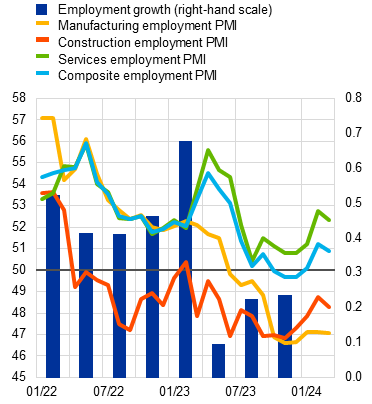 |
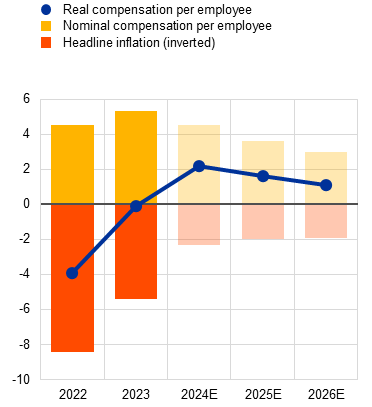 |
Sources: Eurostat and ECB (MNA), S&P Global Market Intelligence, ECB staff macroeconomic projections for the euro area, March 2024 and ECB calculations.
Notes: Panel a: the latest observation for employment growth is for Q4 2023. Panel b: shaded bars are forecasted values from the March 2024 ECB staff macroeconomic projections.
The cost of new borrowing and outstanding debt service have plateaued, while real income growth is supporting households’ debt servicing capabilities. Interest rates on new and renegotiated mortgages as well as on new consumer loans peaked in the fourth quarter of 2023, likely in anticipation of policy rate cuts later in 2024 (Chart 1.8, panel a). Countries with predominantly variable-rate mortgages have seen their debt service costs increase considerably. At the same time, households’ debt servicing capabilities in countries with mainly fixed-rate mortgages will depend on future interest rates when mortgage fixation periods end. The less rapid rise in interest rates together with the recent pick-up in wages across the euro area led to the aggregate debt service-to-income ratio plateauing as of the fourth quarter of 2023. Additionally, households have likely used excess savings accrued during the COVID-19 pandemic to reduce debt burdens in recent years (Overview, Chart 4, panel a), limiting the overall deterioration in their ability to service their debts compared with the previous hiking cycle between 2006 and 2008.
Chart 1.8
Households’ cost of new borrowing has plateaued, and aggregate debt service seems to be at a turning point, as expectations of future debt servicing capabilities worsen
|
a) Euro area household debt service ratio and cost of new borrowing |
b) Expectations of difficulties making mortgage payments in the next three months, by income quintile |
|---|---|
|
(Q1 2003-Q1 2024, percentages) |
(Jan. 2022-Jan. 2024, percentage of consumers) |
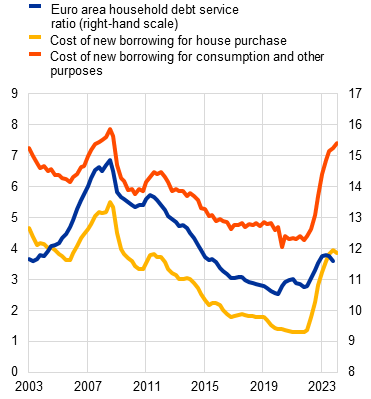 |
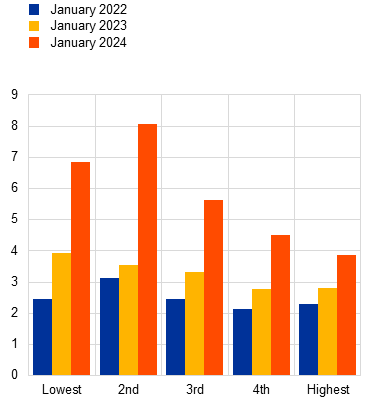 |
Sources: Eurostat and ECB (QSA), ECB (MIR, CES) and ECB calculations.
Notes: Panel a: the latest observation for the household debt service ratio is for Q4 2023. The debt service ratio is defined as the ratio of fixed debt service costs (i.e. interest payments plus amortisations) to disposable income. Fixed debt service costs assume identical repayment of principal over the average maturity of the debt and an average interest rate. Disposable income is expressed as a function of income, the average interest rate and the average remaining maturity of the debt stock. Panel b: the percentage of consumers is calculated using survey weights. The total number of households surveyed includes those who report not having a loan or not knowing how to answer. The sample of countries comprises Belgium, Germany, Spain, France, Italy and the Netherlands, and from April 2022 also includes Ireland, Greece, Austria, Portugal and Finland.
Risks to household financial stability appear manageable at present, yet the share of vulnerable households is rising, especially in lower-income brackets. The combination of persistently strong labour markets, expected high wage growth, healthy savings cushions at pre-pandemic levels and the high share of fixed-rate mortgages in the euro area is ensuring that severe risks to the household sector’s financial situation remain contained.[3] However, the share of households expecting to face difficulties in making mortgage payments in the next three months jumped in January 2024 compared with 2023 (Chart 1.8, panel b). This increase is especially pronounced for both lower- and, unusually, middle-income households. Additionally, microsimulations of household survey data suggest that the share of households with a dangerously high debt service-to-income ratio in countries with mainly variable-rate mortgages increased to around 15% as of the fourth quarter of 2023 from a stable level of around 12% in 2021 and early 2022.[4] While debt held by lower-income households makes up only around 11.4% of total household debt in the euro area, the sharp increase in expected difficulties reported by households in the middle income quintile, which accounts for 14.7% of total household debt, could be indicative of a larger financial stability issue in the future, especially if interest rates do not fall as expected in 2024, real wage growth turns out to be much lower than expected and the labour market weakens notably.
1.5 Correction under way in property markets, notably the commercial segment
Mortgage demand is expected to pick up in the second quarter of 2024, but new lending remains subdued. The steep increase in borrowing costs since the start of the present rate-hiking cycle has, together with subdued consumer confidence and housing market prospects, been the main driver behind the falling demand for mortgages. The decline in demand for new housing loans eased in 2023 and is expected to reverse entirely in the second quarter of this year (Chart 1.9, panel a). If this reversal materialises, it would be the first time in two years that banks have reported net positive demand for mortgages. Expectations that a lower cost of mortgage debt would boost the affordability and attractiveness of housing appear to be the key factor behind this change in outlook. Borrowing costs already declined slightly for four consecutive months between November 2023 and March 2024, bringing the average interest rate from 4.01% to 3.77%. However, the volume of new loans for house purchase remains subdued in 2024 and stands below the lows of 2023 (Chart 1.9, panel b).
Chart 1.9
Banks expect demand for housing loans to increase on the back of lower borrowing costs, but new loan origination remains subdued for the moment
|
a) Changes in demand for mortgage loans in the euro area |
b) New loans to households for house purchase, excluding renegotiations |
|---|---|
|
(Q1 2020-Q2 2024, net balances of survey responses) |
(Jan. 2019-Mar. 2024, € billions) |
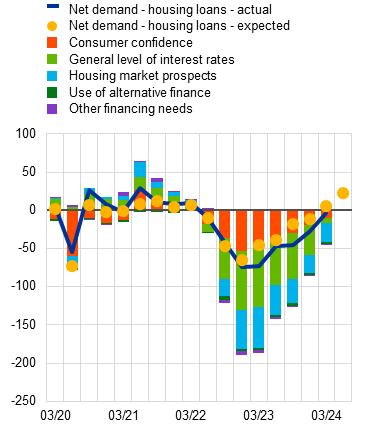 |
 |
Sources: ECB (BLS, MIR) and ECB calculations.
There are some signs of stabilisation in residential real estate (RRE) prices, but downside risks remain. Euro area RRE prices declined 1.1% year on year in the fourth quarter of 2023. This fall in aggregate euro area RRE prices masks significant differences across countries, with around two-thirds of euro area countries still exhibiting positive price dynamics in the same period. In addition, high-frequency data on RRE prices available for a selected number of countries indicate that the drop in RRE prices in some countries might have slowed or even come to a halt in the second half of last year (Chart 1.10, panel a). The orderly contraction in RRE prices has led to a reduction in overvaluation measures, which is reflected in slightly lower tail risk for euro area RRE prices compared with the third quarter of 2022 (Chart 1.10, panel b). Nonetheless, downside risks remain elevated in some euro area countries, as housing affordability is at low levels owing to high interest rates and high prices, with some markets still showing signs of overvaluation. The tightening in financial conditions has been followed by a stark deceleration in RRE investment, which will likely have a negative impact on supply going forward (Chart 1.10, panel c). The reduction in housing supply and expectations of rising construction prices, albeit much slower than in the recent past, might to some extent mitigate the risk of prices falling substantially going forward.
Chart 1.10
The orderly contraction in RRE prices has reduced tail risks to RRE prices, but significant downside risks are likely to persist in some countries
|
a) RRE price dynamics in selected countries |
b) One-year forward predicted tail risk in euro area RRE prices |
c) Survey indicators on residential construction and residential investment growth |
|---|---|---|
|
(Dec. 2019-Mar. 2024; index: Dec. 2019 = 100) |
(Q1 2016-Q2 2024, percentages) |
(Jan. 1999-Mar. 2024; left-hand scale: net percentages and percentages, right-hand scale: index) |
 |
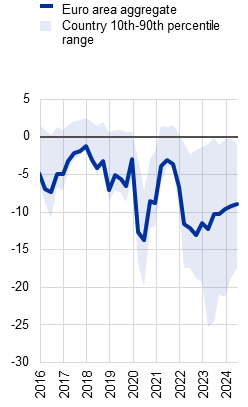 |
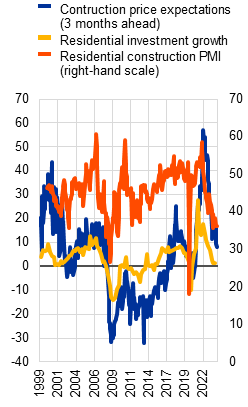 |
Sources: ECB, Europace, Immobiliare.it (Italy), Confidencial Imobiliário (Portugal, sourced from BIS), Arco Real Estate (Latvia), Národná banka Slovenska, Statistics Finland, Indominio.es (Spain), Central Statistics Office (Ireland), Statistics Netherlands, S&P Global Market Intelligence and ECB calculations.
Notes: Panel a: the chart includes monthly data up to December 2023, February 2024 or March 2024 for the following countries: Germany, Ireland, Spain, Italy, Latvia, the Netherlands, Portugal and Finland. The data for Slovakia are quarterly and up to December 2023. An average listing price index is used for Italy, while a hedonic price index based on transaction prices is used for all the other countries. Data for Latvia reflect prices of apartments in Riga and thus only a portion of the country’s real estate market. The data for Portugal capture around 40% of the real estate market, as transactions that do not go through estate agents are excluded. As a result, official country statistics might differ from the data provided here, as they capture the entire market at the cost of lower frequency. Panel b: the chart shows the results from an RRE price-at-risk model based on a panel quantile regression on a sample of 19 euro area countries. The chart shows the 5th percentile of the predicted RRE price growth for the euro area aggregate and the 10th-90th percentile range of this estimate across individual euro area countries. Further details on the methodology can be found in the article entitled “The analytical toolkit for the assessment of residential real estate vulnerabilities”, Macroprudential Bulletin, Issue 19, ECB, October 2022.
The outlook for offices and lower-quality commercial real estate (CRE) continues to deteriorate, which is having a negative effect on the resilience of real estate firms. Transaction activity in CRE markets remains subdued, with almost half as many transactions completing in the last two quarters of 2023 as in the equivalent period in 2022. Furthermore, market intelligence indicates little to no pick-up in activity over the start of 2024. While this low level of market activity is inhibiting price discovery, there is already evidence of a significant price correction occurring in markets, with prices down 8.7% annually as of the fourth quarter of 2023 (Overview). The outlook for the office market is particularly bleak. Increased use of work-from-home options has created a structural drop in demand for this asset, which is reflected in a significant decline in rent growth expectations compared with pre-pandemic dynamics. Lower-quality assets are the most affected, and expectations in this segment continue to deteriorate due to additional concerns about energy efficiency requirements and capital expenditure costs. However, conditions in euro area markets do appear more benign than in the United States, attributable to more extensive working from home in the United States combined with an excess of supply going into the downturn (Chart 1.11, panel a). Falling rental income, rising capital expenditures and higher financing costs pose a triple threat to real estate firms. The largest real estate firms in the euro area have seen their profit margins contract sharply since the start of 2022, which has left around half of them in loss-making territory (Chart 1.11, panel b).
Chart 1.11
The outlook for CRE markets continues to deteriorate, with real estate firms facing increasing profitability pressure
|
a) 12-month rent growth expectations for the office market |
b) Share of firms with negative net profit in the real estate sector and median net profit margin |
|---|---|
|
(Q4 2023, percentages) |
(Q1 2017-Q3 2023, percentages) |
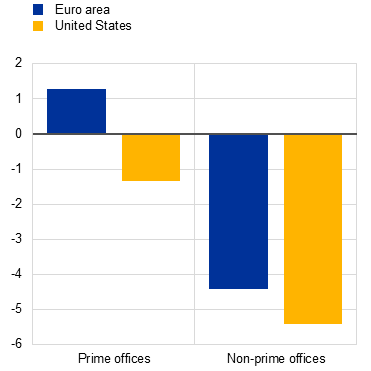 |
 |
Sources: RICS, S&P Global Market Intelligence and ECB calculations.
The downturn in RRE markets has remained orderly thus far, while some signs of materialising risk can be observed in CRE markets. The downward adjustment in RRE prices remains orderly, with signs of stabilisation in some countries. Generally, the contraction in RRE prices has been larger in countries where properties showed signs of greater overvaluation at the start of the rate hike cycle. Risks remain tilted to the downside, however, especially in those countries where debt levels are elevated and properties might still be overvalued. The commercial segment has seen a steeper downturn, and rising financing costs pose challenges to the debt servicing capacity of real estate firms, especially where rental income is also under pressure. This development is reflected in positive and rising non-performing loan inflows in banks’ CRE portfolios, although these remain contained for now. Banks’ aggregate exposures are substantially smaller to CRE than to RRE and are unlikely to be large enough at the euro area level to threaten the solvency of the banking system as a whole. However, these exposures are not evenly spread across the banking system, and stress could arise among the euro area’s most exposed banks (Chapter 3). Additionally, an adverse outcome of such a scenario could be amplified by procyclical selling among non-banks, particularly real estate investment funds (Chapter 4).
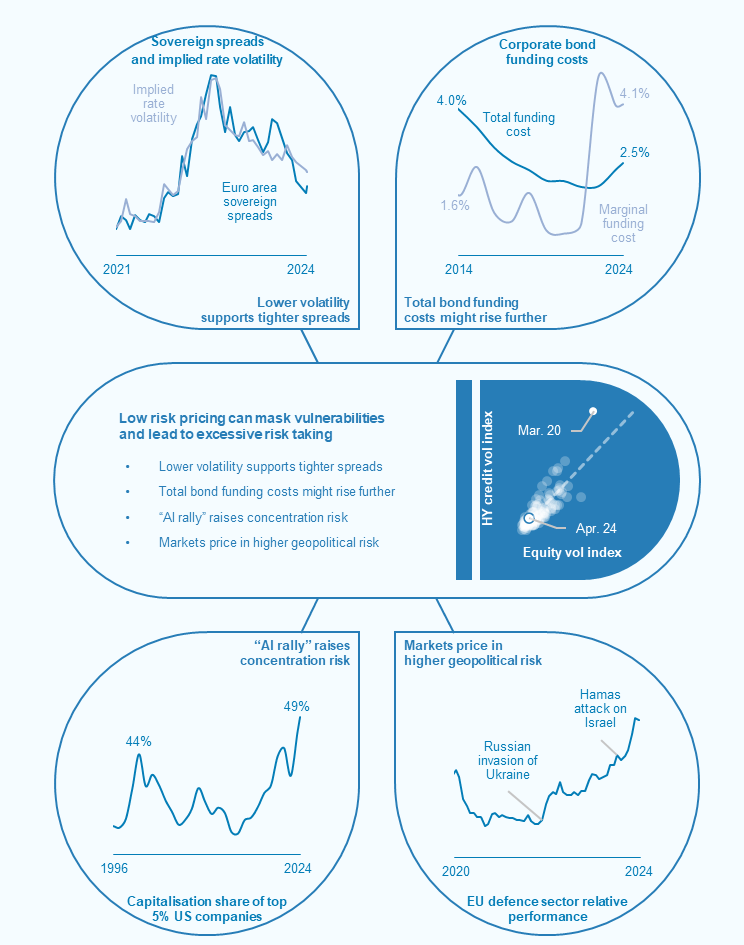
2.1 Markets adjust to expected shift in monetary policy
Expectations of global monetary policy easing have been boosting investor demand for risky assets. The disinflation trend, partly supported by moderating energy prices, has led to investor expectations that major central banks will start to ease monetary policy in 2024. Market participants are currently pricing-in around 115 basis points of policy rate cuts over the next 12 months in the euro area and 95 basis points in the United States (Chart 2.1, panel a). While longer-dated risk-free rates rebounded from the strong decline observed close to the end of 2023, the expected shift in monetary policy still supported risky asset valuations. Increased risk appetite contributed to the strong outperformance of the riskiest asset classes (Chart 2.1, panel b). While some positive economic surprises in the first months of 2024 have led investors to postpone their expectations surrounding the timing of a first policy rate cut, investors remain confident that inflation in advanced economies might reach its 2% target without a deep economic contraction (a “soft landing”).
Chart 2.1
Shift in monetary policy prospects has boosted investor confidence and risk appetite
|
a) Expected policy rate changes over the next 12 months |
b) Global asset class performance since the previous issue of the Financial Stability Review |
|---|---|
|
(Jan. 2021-May 2024, basis points) |
(22 Nov. 2023-7 May 2024, percentages) |
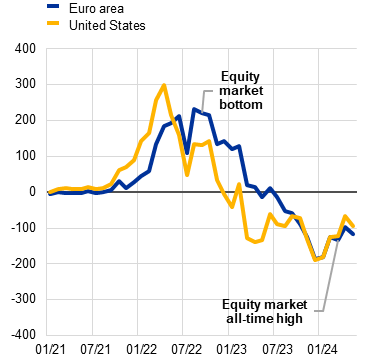 |
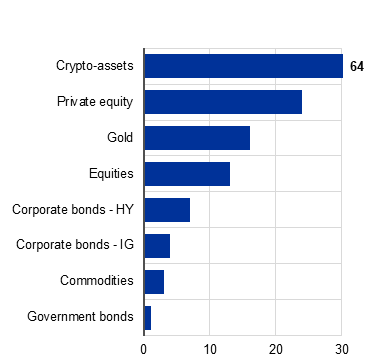 |
Sources: Bloomberg Finance L.P. and ECB calculations.
Notes: Panel a: the latest observations are for 7 May 2024. The chart shows the difference between 1Y1M forward overnight index swap (OIS) rates and current overnight rates (euro area – €STR, United States – SOFR). The equity market bottom and all-time high indicated are based on the daily-close values for the EURO STOXX Index. Panel b: HY stands for high yield; IG stands for investment grade. Performance is based on the following indices: crypto-assets – Bloomberg Galaxy Crypto Index; private equity – FTSE Private Equity Buyout Index (for United States); equities – MSCI ACWI Index; bonds – ICE BofA indices; commodities – Bloomberg Commodity Index Total Return.
Positive real risk-free rates might mitigate some financial stability concerns but might also challenge the most vulnerable corporates. Investor expectations suggest that while policy rates will go down, they will remain well above the zero lower bound. Consequently, long-term real risk-free rates are expected to remain in positive territory – at around 0.25% for the euro area – also in steady state (Chart 2.2, panel a). While the era of negative interest rates in the decade before the inflation outbreak was associated with the rise of a number of financial stability risks, the new regime may bring long-term benefits for the stability of the financial system.[5] Nevertheless, the ongoing period of transition could still expose some vulnerabilities and increase market volatility. For example, the stress seen in the banking sector in March 2023 showed that some individual financial entities are particularly vulnerable to interest rate risk. Since then, market participants have priced in tail risks as skewed to the downside, as reflected in the prices of options on short-term sovereign bonds (Chart 2.2, panel b).
The structure of the corporate bond market has delayed the full impact of higher interest rates on businesses. One way corporates can hedge against the impact of unexpected interest rate changes on their funding costs is to issue fixed-rate bonds instead of floating-rate bonds. In this case funding costs mostly increase when the debt has to be rolled over in a higher-rate environment. Given that fixed-rate bonds are dominant in corporate bond structures in both the euro area and the United States (Chart 2.3, panel a), the aggregated impact of past policy tightening has been smoothed over time.[6] In addition, in the euro area lower-rated corporate borrowers issued a record amount of debt shortly before the onset of the recent tightening cycle, which has also kept the share of bonds maturing in the near term at low levels (Chart 2.3, panel b). This enabled lower-rated borrowers to reduce issuance in 2022 and 2023, which shielded them from the immediate effects of higher risk-free rates and wider spreads on their funding costs. However, increased rollover needs going forward might accelerate the impact of higher rates. Furthermore, the recently observed shift towards shorter debt maturities is leaving lower-rated firms more exposed to future market conditions.
Total bond funding costs are still expected to increase further. At the end of 2021, marginal bond funding costs were substantially lower than total bond funding costs in both the euro area and the United States (Chart 2.4, panel a), indicating that pandemic-related policy easing had not yet been fully transmitted. The rapid increase in bond yields over 2022 has reversed these dynamics but, until recently, the overall increase in total bond funding costs had been relatively limited. While current bond yields reflect the policy rate cuts anticipated by investors, the limited scale of the expected easing cycle leaves scope for further total funding cost increases (proxied by the distance to the 45-degree line in the chart). This might put pressure on more indebted corporates, especially if the subdued economic growth currently observed in the euro area continues. In the sovereign bond space, while total funding costs are also expected to increase further, the scale of expected increase varies substantially across individual countries (Chart 2.4, panel b). In contrast to the situation for corporates, it appears that more of the past tightening has already been transmitted to more indebted sovereign issuers than to less indebted ones (the higher the marginal cost of bond funding, the closer it is to the total cost of bond funding). This is because of the significant amount of lower-rated sovereign debt which has already been rolled over at higher rates. In addition, the recent substantial compression of spreads has further mitigated the expected additional increase in average sovereign funding costs.
Chart 2.4
Bond funding costs will increase further as issuers refinance their debt
|
a) Total versus marginal corporate bond funding costs by jurisdiction |
b) Total versus marginal euro area sovereign bond funding costs by country |
|---|---|
|
(Dec. 2021-May 2024, percentages) |
(Dec. 2021-May 2024, percentages) |
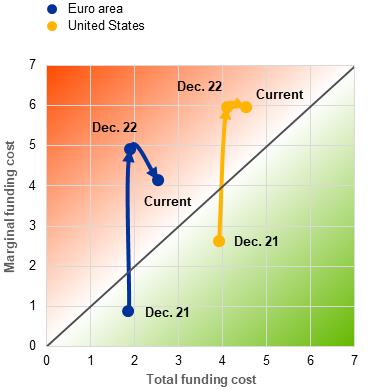 |
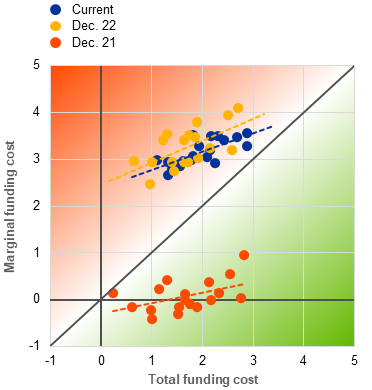 |
Sources: Bloomberg Finance L.P. and ECB calculations.
Notes: The latest observations are for 7 May 2024. Total funding cost is proxied by the average yield at issue on outstanding fixed-rate bonds weighted by the amount outstanding. When data on yield at issue were not available the coupon rate was used instead. The marginal funding costs are proxied by the average yield-to-worst on outstanding fixed-rate bonds weighted by the amount outstanding. Panel a: calculated for bonds included in ICE BofA indices: Euro Corporate Index, Euro High Yield Index, US Corporate Index, US High Yield Index. Panel b: calculated for bonds included in the ICE BofA All Maturity All Euro Government Index.
2.2 Benign pricing of risk keeps asset prices vulnerable to shocks
Low risk perceptions might mask underlying vulnerabilities and lead to excessive risk-taking. Since the publication of the previous edition of the Financial Stability Review in November 2023, implied volatility indices for risky asset classes have remained subdued both in historical terms and in comparison with the implied volatility in the interest rate markets (Chart 2.5, panel a). Given the role played by diversified equity indices in reflecting broad macroeconomic conditions, volatility indicators based on them (such as VIX and VSTOXX) are perceived as benchmark market-based risk indicators. While low implied volatility in financial markets can support financial stability to the extent that it properly reflects sound fundamentals and a stable risk outlook, it might also reflect some underestimation of financial stability vulnerabilities by market participants (Box 2). In addition, because financial institutions commonly use implied volatility indices in their risk management, prolonged periods of subdued volatility might incentivise excessive risk-taking.[7] This could, in turn, lead to a substantial compression of risk premia (Chart 2.5, panel b) and add to non-linear dynamics during shocks.[8]
Chart 2.5
Most implied volatility indices remain subdued and might incentivise risk-taking
|
a) Implied volatility indices against the distribution for the last ten years |
b) Risk premia versus implied volatility indices for euro area risky assets |
|---|---|
|
(8 May 2014-7 May 2024, percentiles) |
(May 2014-Apr. 2024, percentages) |
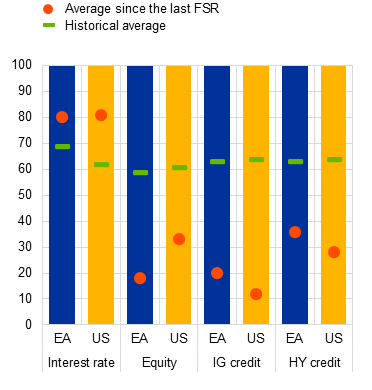 |
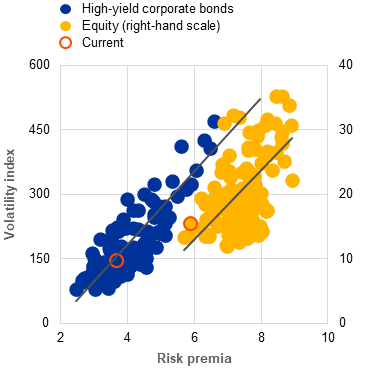 |
Sources: Bloomberg Finance L.P. and ECB calculations.
Notes: Panel a: IG stands for investment grade; HY stands for high yield. Based on the following indices for the euro area and the United States respectively: interest rate – SMOVE, MOVE; equity – VSTOXX, VIX; IG credit – Itraxx/Cboe Europe Main 1M Volatility Index, CDX/Cboe IG 1M Volatility Index; HY credit: Itraxx/Cboe Europe Crossover 1M Volatility Index, CDX/Cboe HY 1M Volatility Index. Panel b: for high-yield corporate bonds “risk premia” is proxied by option-adjusted spreads for the ICE BofA Euro High Yield Index while for equities it is proxied by the 5Y CAPE yield over the 5Y real risk-free rate for EURO STOXX.
The rally in equity markets has pushed both valuations and concentration levels higher. Robust earnings, investor optimism and the related compression of risk premia have resulted in a strong equity performance in recent months, taking major indices to all-time highs. In the United States, some equity valuation metrics have reached decade-high values (Chart 2.6, panel a), fuelling concerns of overvaluation or, even, an AI-related asset price bubble. Although cyclically adjusted metrics are still below dotcom bubble levels, they are also substantially above the historical median, suggesting that there is scope for a market correction and lower long-term returns going forward (Chart 2.6, panel b). In addition, there have been increasing concerns over heightened market concentration, as the largest companies in the United States now account for a historically high share of broad index capitalisation (Chart 2.6, panel c). This could lead to the prevalence of idiosyncratic risks related to the key themes driving earnings expectations higher – as was the case for internet development in the 1990s and is the case for AI currently. Elevated uncertainty surrounding the ultimate impact of AI on the real economy could therefore contribute to high volatility in the overall equity market, irrespective of whether the “AI rally” is displaying asset price bubble dynamics or not. In the euro area, while market concentration has also risen, equity valuation indicators have not increased to the levels seen in the United States. As the respective equity markets are deeply integrated, financial stability risks for the euro area might relate mostly to spillovers from the United States or to potential negative earnings surprises, particularly if subdued economic growth continues.
Chart 2.6
Heightened US equity valuations indicate scope for a larger market correction, while extreme market concentration might indicate elevated idiosyncratic risks
|
a) Equity market composite valuation metric relative to the ten-year average |
b) CAPE ratio and subsequent long-term realised returns in the US equity market |
c) Share of the top 1% of companies in broad equity index capitalisation |
|---|---|---|
|
(Jan. 2021-Apr. 2024, z-scores) |
(Jan. 1988-Apr. 2024; ratio, percentages) |
(Jan. 1995-May 2024, percentages) |
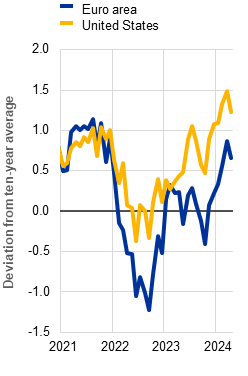 |
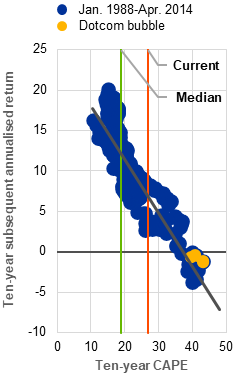 |
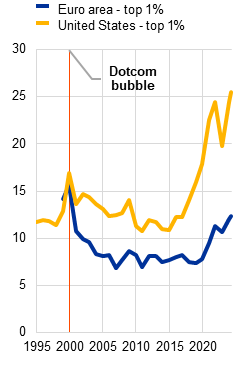 |
Sources: Bloomberg Finance L.P. and ECB calculations.
Notes: Panel a: average z-scores of the following valuation metrics for EURO STOXX (euro area) and the S&P 500 (United States): price-to-book ratio, price-to-forward (12-month) earnings ratio, price-to-long-term (ten-year) inflation-adjusted earnings ratio, price/earnings-to-growth ratio (growth rate calculated as the average of annualised five-year historical earnings growth and annualised two-year blended-forward earnings growth) and inverse risk premia proxied by five-year CAPE yield less five-year real (inflation-swap-adjusted) government bond yield (German for the euro area). Panel b: CAPE stands for cyclically adjusted price-to-earnings, where earnings for the last ten years are adjusted by inflation and averaged. Calculations are for the S&P 500. “Dotcom bubble” refers to the period between December 1999 and March 2000. Panel c: the latest observations are for 7 May 2024, calculated for the EURO STOXX (euro area) and the S&P 500 (United States).
While the corporate sector is perceived as resilient on aggregate, pockets of vulnerabilities have become more apparent. Buoyant investor sentiment has also been observed in the corporate bond market. Progress seen in the convergence of inflation towards central bank targets has strengthened baseline expectations among investors that the global economy will experience a soft landing. In such a scenario, default rates – even those for more indebted borrowers – are expected to remain contained, which has supported the continued compression of high-yield bond spreads in both the euro area (Chart 2.7, panel a) and the United States (Chart 2.7, panel b). While this would be a desirable outcome from a financial stability perspective, there are still some concerns over the heterogeneous situation of individual sectors. In the euro area, this has been reflected in the substantial increase in spread dispersion to levels last seen during the global financial crisis (Chart 2.7, panel c). The sectoral split indicates that distressed borrowers are concentrated in the real estate sector, which has recently become more vulnerable because of the downturn in the commercial segment (Chapter 1). While the small share of such troubled borrowers points to limited potential spillovers to the broader corporate bond market, it might reflect the deteriorating asset quality of some bank loan portfolios (Chapter 3). By contrast, in the United States spreads have compressed substantially even for the lowest-rated borrowers, which might reflect a better economic outlook.
Chart 2.7
Corporate spread compression reflects optimism about borrowers’ resilience, but sectoral-specific risks seem to be on the rise
|
a) Default rate forecast and spread for high-yield bonds in the euro area |
b) Default rate forecast and spread for high-yield bonds in the United States |
c) Dispersion of high-yield bond spreads in the euro area and the United States |
|---|---|---|
|
(Jan. 2020-Apr. 2024; left-hand scale: percentages, right-hand scale: basis points) |
(Jan. 2020-Apr. 2024; left-hand scale: percentages, right-hand scale: basis points) |
(Jan. 2008-May 2024, basis points) |
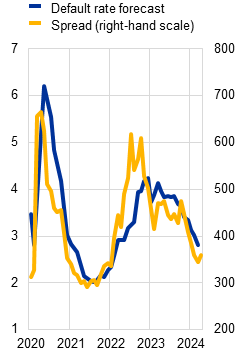 |
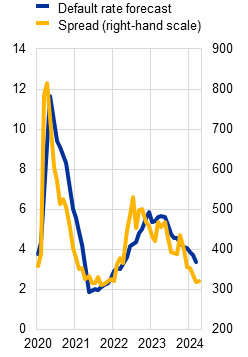 |
 |
Sources: Bloomberg Finance L.P., Moody’s Analytics and ECB calculations.
Notes: Panel a: option-adjusted spreads for the ICE BofA Euro High Yield Index and the 12-months-ahead baseline default rate forecast for European high-yield bonds by Moody’s. Panel b: option-adjusted spreads for the ICE BofA US High Yield Index and the 12-months-ahead baseline default rate forecast for US high yield-bonds by Moody’s. Panel c: the latest observations are for 7 May 2024. The difference between the option-adjusted spreads for BB and CCC (or lower) bonds included in ICE BofA Bond Indices.
Investor concerns about euro area sovereign debt sustainability have decreased greatly, despite medium-term vulnerabilities. Declining uncertainty in the interest rate market has continued to be one of the key drivers of sovereign spread compression in the recent period (Chart 2.8, panel a). In addition, substantial debt issuance by more vulnerable countries has been well absorbed by market participants, in part due to the growing demand for duration exposure. Investors have become more confident that risks in the sovereign bond market will remain contained. Consequently, the market pricing of sovereign credit risk still appears benign in comparison with the views of credit rating agencies (Chart 2.8, panel b). Because of the rise in interest expenses and still-elevated debt levels, some euro area countries may experience significant spread widening if they are unable to consolidate their fiscal positions. This may prove challenging, given the subdued economic growth outlook (Chapter 1).
Chart 2.8
While sovereign spread compression is supported by the declining implied volatility of interest rates, investors might be overly optimistic in their assessment of risk
|
a) Euro area sovereign spreads and implied interest rate volatility |
b) Euro area sovereign ratings versus market-implied ratings |
|---|---|
|
(Jan. 2021-May 2024; left-hand scale: basis points, right-hand scale: index) |
(7 May 2024; Moody’s rating, standardised rating scale) |
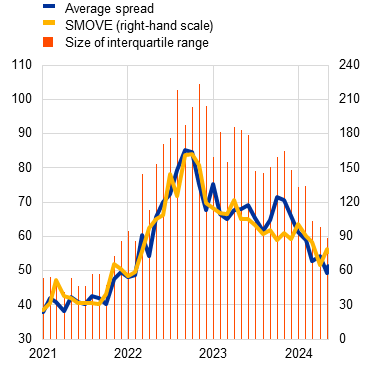 |
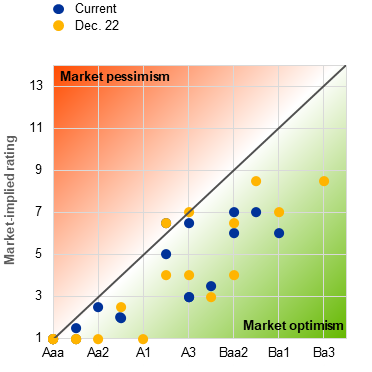 |
Sources: Bloomberg Finance L.P., Moody’s Analytics and ECB calculations.
Notes: Panel a: the latest observations are for 7 May 2024. Spreads are against German bonds for bonds included in the ICE BofA All Maturity All Euro Government Index (excluding German bonds). Average is weighted by the amount outstanding. The size of the interquartile range shows the difference between the first and third quartiles of the distribution of spreads across bonds. Panel b: each data point shows an average of market-implied ratings from bond and credit default swap (CDS) pricing, based on Moody’s MIR methodology.*
*) See Dwyer, D.W., Moore, D. and Wang, Y., “Moody’s Market Implied Ratings: Description and Methodology”, Moody’s Analytics.
Box 2
Low implied equity market volatility could underestimate financial stability vulnerabilities
Implied equity market volatility has been low in recent years, in both absolute and relative terms. Abstracting from short-lived spikes, implied equity market volatility has broadly declined since March 2020, despite tighter monetary policy, rising geopolitical tensions and a balance of risks to economic growth tilted to the downside. At the current juncture, low implied volatility in equity markets contrasts with signals from some leading economic indicators (Chart A, panel a) and still-elevated implied volatility in interest rate markets; the ratio of the two is at the lowest level in decades for both the United States and the euro area (Chart A, panel b). In addition, the subdued volatility skewness in the equity markets points to benign pricing of the downside risks (Chart A, panel c). This box discusses factors behind low levels of implied equity market volatility, its divergence from the implied volatility in interest rate markets and possible implications for financial stability, including underestimation of risks and related to this excessive risk-taking.
2.3 Exogenous risks could add to volatility in euro area markets
Risks from the US Treasury market might spill over to euro area markets. Since the onset of higher inflation in 2021, implied volatility in interest rate markets has increased substantially, undermining the liquidity of the US sovereign bond market (Chart 2.9, panel a). In addition, the regulatory reforms implemented in response to the global financial crisis have constrained banks’ market making capacity, while the supply of government bonds has continued to grow.[9] This combination of cyclical and structural factors adversely affecting market liquidity has increased the likelihood and magnitude of price dislocations, attracting some non-bank financial institutions which saw this as an arbitrage opportunity (Box 3). Although such activity is, in principle, beneficial for market efficiency, a forced unwinding of leveraged exposures at a time of severe market stress might add to volatility, as is believed to have been the case in March 2020. That said, conditions in the US Treasury market remain fragile and, given the role of these securities as global risk-free assets, the risk of spillovers to euro area markets remains high.[10]
Growing US debt sustainability concerns might increase financial market volatility. The rapid tightening of monetary policy substantially increased the US government’s net interest payments not only nominally, but also in relation to budget revenues (Chart 2.9, panel b). The expected further growth of these expenses has increased concerns about US debt sustainability, as reflected in a number of negative rating actions and in market-based measures of US credit risk, such as CDS spreads. On the basis of its long-term projections, the US Congressional Budget Office has indicated that unabated future increases in debt could slow economic growth, push up interest payments to foreign holders of US debt and pose significant risks to the fiscal and economic outlook.[11] Although a technical default on outstanding debt would be an extreme tail risk, a significant rise in US Treasury bond yields or an induced economic shock could weigh on other assets globally.
Although sentiment is buoyant, market participants are trying to weigh up geopolitical risks. Since the beginning of the unjustified Russian invasion of Ukraine, investors have increased their attention to geopolitical risks, as reflected by the frequency at which the topic is mentioned in corporate calls with market participants and analysts (Chart 2.10, panel a). The risk of the conflict escalating has also been reflected in the outperformance of defence sector companies, especially in the euro area, where military spending has already risen significantly and is expected to rise still further. In addition, gold prices have recently reached all-time highs, likely driven by the demand for geopolitical risk hedges. While the immediate market reaction to Hamas’ attack on Israel has been quite muted, increased tail risks have also been priced in by the energy market, which is often an important channel of geopolitical risk contagion (Special Feature A). Risks to crude oil prices are typically skewed to the downside, but when geopolitical risks grow this pattern inverts, as reflected by the option-implied volatility skewness (Chart 2.10, panel b). That said, the potential escalation of international conflicts, especially when they involve or are close to important commodity exporters, might increase the risk of negative supply shocks substantially. Such a scenario could undermine disinflation efforts and put significant pressure on asset valuations.
Chart 2.10
Investors are mindful of geopolitical risks which might, for example, increase the likelihood of negative supply shocks
|
a) Defence sector’s relative performance and references to “geopolitics” in corporate calls |
b) Crude oil volatility skewness vs geopolitical risk index |
|---|---|
|
(Jan. 2020-Apr. 2024; left-hand scale: Dec. 2021 = 100, right-hand scale: thousands) |
(Jun. 2014-May 2024; index, percentages) |
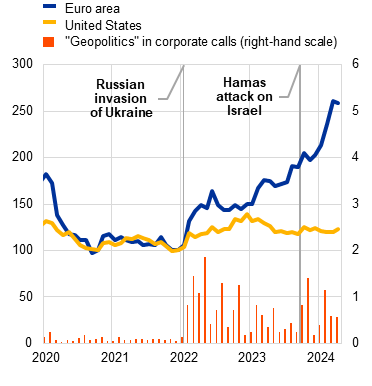 |
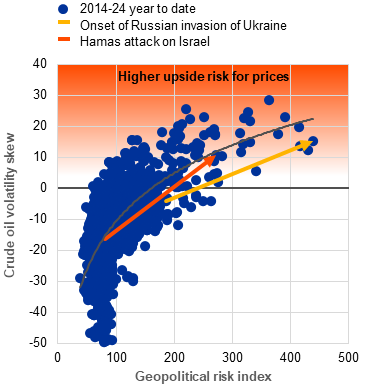 |
Sources: Bloomberg Finance L.P. and ECB calculations.
Notes: Panel a: ratio of defence sector sub-indices (euro area – UBS EU Defense Spending Index, United States – UBS Defense Spending Index) over broad market indices (euro area – EURO STOXX, United States – S&P 500). The total number of references includes the word “geopolitics” and Bloomberg-suggested synonyms. Panel b: the latest observations are for 7 May 2024. Volatility skew reflects the difference between implied volatility in 1M 5DC and 5DP options on crude oil. “Onset of Russian invasion of Ukraine” refers to the change between 17 February and 3 March 2022, while “Hamas’ attack on Israel” refers to the period 6 October to 23 October 2023. For the geopolitical risk index, a seven-day moving average version is used.*
*) See Caldara, D. and Iacoviello, M., “Measuring Geopolitical Risk”, American Economic Review, Vol. 112, No 4, April 2022, pp. 1194-1225.
Box 3
Financial stability risks from basis trades in the US Treasury and euro area government bond markets
Basis trades are arbitrage strategies which improve market functioning but are subject to specific risks, especially when excessively leveraged. Basis trades typically aim to exploit any mispricing between the spot price of a security (adjusted for the funding cost until the expiry of a futures contract) and its futures price – the difference being called the net basis. In order to do this, an arbitrageur needs to simultaneously conclude two opposing trades – one in the futures market and the other in the spot market. As the futures contract approaches its maturity, the futures price and the spot price converge, arguably making the basis trade return risk-free if held until the futures contract expires. In principle, therefore, basis trades are not speculative in nature and should have a beneficial impact on market efficiency and liquidity. Given that price dislocations are typically small compared with the market value of the relevant security, arbitrageurs often employ high leverage to enhance their returns. In the spot market, leverage is employed using repo funding (securities are pledged as collateral and the cash received is used to purchase more securities), while in the futures market, leverage is synthetic and stems from the obligation to post only a fraction of the nominal exposure as margin. This exposes basis trades to funding risks – the inability to roll over repo borrowing at an acceptable price – and liquidity risks – the inability to meet margin calls related to futures positions. Rapid unwinding of basis trades in response to forced deleveraging, for instance, could add to price dislocations. However, such a scenario is less likely for arbitrage strategies and would have less impact on prices than would be the case for leveraged directional positions.[12]
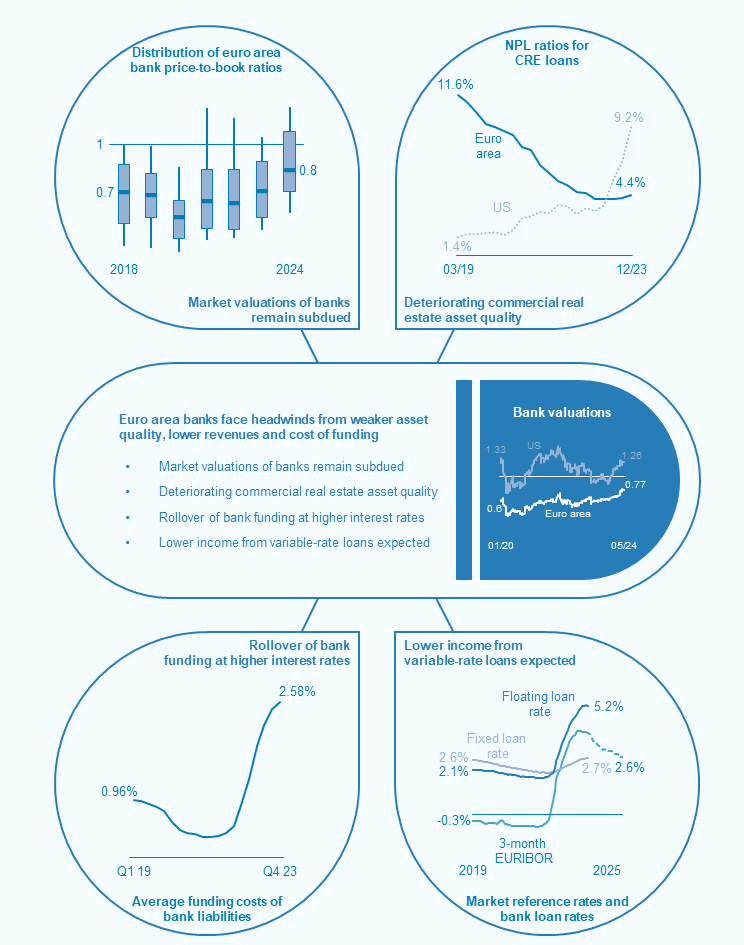
3.1 Profitability peaked at multi-year highs as headwinds to income strengthen
Euro area bank profitability peaked in the second half of 2023, as cost pressures intensified and operating profits weakened. Annual bank profitability reached a high of 9.3% in 2023, a level last seen before the global financial crisis. However, significant institutions already saw their four-quarter trailing return on equity (ROE) decline slightly in the final quarter of the year compared with the previous quarter. The turn in profitability is made all the clearer by quarterly data, as the annualised quarterly ROE fell to 7.6% in the fourth quarter of 2023 from a peak of 10.6% in the second quarter (Chart 3.1, panel a)[13]. This decline was broad-based, driven by rising operating expenses, lower operating income and higher loan-loss provisions (Chart 3.1, panel b). As a further indicator of increasing challenges to cost control, the weighted average quarterly cost/income ratio of euro area banks increased significantly in the fourth quarter of 2023, to 61%, returning to levels observed one year ago (Chart 3.1, panel c). This reflects a quarterly increase of 13% in operating expenses, including an increase of 14% in staff costs. This sharp quarterly increase might, however, reflect some seasonality, as costs increased more moderately compared with the fourth quarter of 2022, with quarterly operating and staff costs rising by 4.2% and 6.2% respectively year on year. This compares with euro area inflation and wage growth of 2.9% and 4.5% respectively in 2023 (Chapter 1).
Significant institutions’ net interest income stagnated in the fourth quarter of 2023, amid early indications that interest margins might be narrowing. After increasing steadily in the eight preceding quarters, euro area banks’ net interest income ceased to grow during the fourth quarter. Lower loan volumes have fully offset the positive contribution of expanding net interest margins (NIMs) (Chart 3.2, panel a). However, NIMs typically trail developments in loan-deposit spreads charged by banks. These spreads started to decline during the fourth quarter, indicating that NIMs may follow suit in the near future (Chart 3.2, panel b).
Chart 3.2
Net interest income growth stagnated as loan volumes declined while interest rate spreads started to tighten
|
a) Quarterly changes in net interest income of euro area banks |
b) Interest rate spreads and net interest margins of euro area banks |
|---|---|
|
(Q4 2021-Q4 2023, percentages) |
(Jan. 2016-Mar. 2024, percentage points, percentages) |
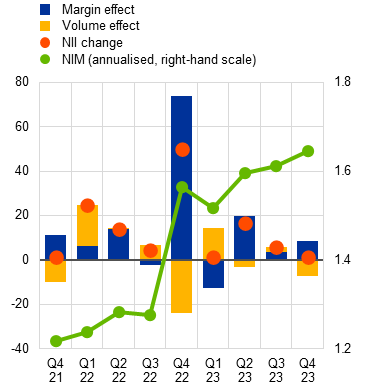 |
 |
Sources: ECB (supervisory data, MIR) and ECB calculations.
Notes: Panel a: NII stands for net interest income; NIM stands for net interest margin, calculated as net interest income divided by total assets. The chart shows quarter-on-quarter changes in NII. Based on a balanced sample of 80 euro area significant institutions. Panel b: based on all euro area banks.
Weak loan demand and tight credit standards suggest that loan growth will remain subdued. Rates charged by banks on new loans to households and non-financial firms have already lost momentum over recent months and appear to have reached their peak (Chart 3.3, panel a). Year-to-date bank lending flows to the non-financial private sector were at record lows at the end of March, driven by large reductions in mortgage lending and loans to non-financial corporations (NFCs) (Chart 3.3, panel b). Banks have tightened their credit standards further since the previous issue of the Financial Stability Review was published and expect those standards to tighten again over the second quarter of 2024, which should further dampen loan growth over the medium term. At the same time, the demand for loans from households and NFCs has weakened further but is expected to recover slightly during the second quarter of 2024 (Chart 3.3, panel c).
Chart 3.3
Bank loan rates have peaked amid weak lending dynamics and tightening credit standards
|
a) Policy rate and bank loan rates on new business |
b) Year-to-date bank lending flows, to March |
c) Demand for loans to households and NFCs and lending standards |
|---|---|---|
|
(Jan. 2021-Apr. 2024, percentages) |
(2004-24, € billions) |
(Q1 2004-Q2 2024, net percentages) |
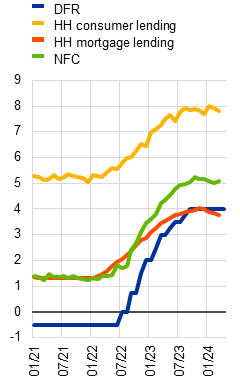 |
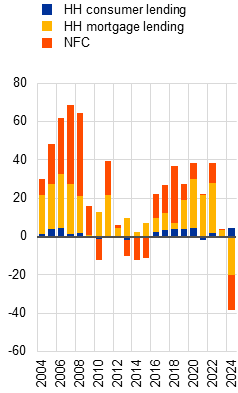 |
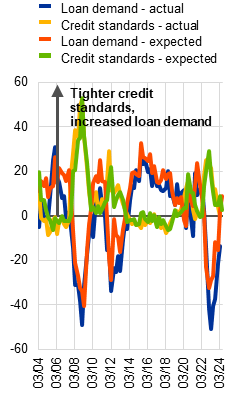 |
Sources: ECB (MIR, BSI, BLS) and ECB calculations.
Notes: Panel a: DFR refers to the ECB’s deposit facility rate. HH stands for households. Panel b: lending flows correspond to flows for January-March for each year. Panel c: “Actual” values are changes that have occurred, while “expected” values are changes anticipated by banks. For credit standards, net percentages are defined as the difference between the sum of the shares of banks responding “tightened considerably” and “tightened somewhat” and the sum of the shares of banks responding “eased somewhat” and “eased considerably” in the ECB’s bank lending survey (BLS). Net percentages for the questions on demand for loans are defined as the difference between the sum of the shares of banks responding “increased considerably” and “increased somewhat” and the sum of the shares of banks responding “decreased somewhat” and “decreased considerably”. Net percentages have been aggregated by taking the weighted average across the three loan categories.
Floating-rate assets could weigh on banks’ interest income, as market reference rates are expected to fall. Three-quarters of the increase in banks’ interest income from loans can be linked to loans remunerated at variable rates. This is because these loans repriced alongside rising market reference rates while rate dynamics for fixed-rate loans have remained comparably muted (Chart 3.4, panel a). However, floating-rate loans become a headwind for bank profitability under assumptions of an imminent turn in market reference rates, as implied by current market expectations. Similarly, banks’ liquid assets, such as central bank reserves, reverse repos and short-term debt securities, have been a major source of increased profits, but their yields would shrink quickly once market interest rates fell. Banking systems with large shares of floating-rate loans and liquid assets are the most exposed to declining market reference rates, including several countries where almost the entire loan book to NFCs has been granted at variable rates (Chart 3.4, panel b).
Chart 3.4
Variable-rate loans have been the main driver of increases in banks’ loan interest income but would become a headwind to profits if market interest rates fall
|
a) Euro area bank interest income contributions and lending rates on fixed- and floating-rate loans to households and NFCs |
b) Share of variable-rate bank lending to NFCs, by country |
|---|---|
|
(left graph: Dec. 2021, Mar. 2024, € billions; right graph: Jan. 2019-Nov. 2025, percentages) |
(Feb. 2024, percentages) |
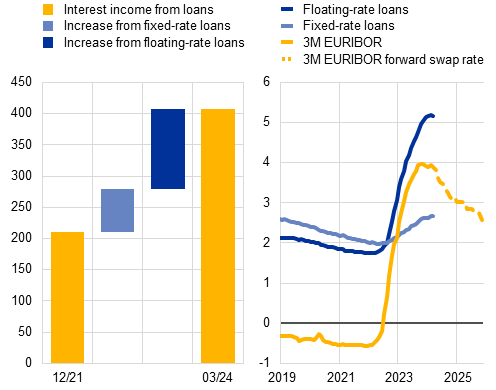 |
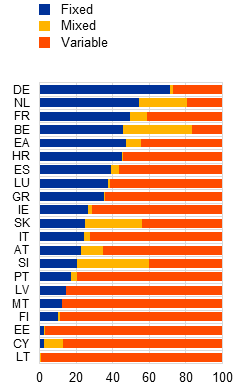 |
Sources: Bloomberg Finance L.P., ECB (MIR, BSI, AnaCredit) and ECB calculations.
Notes: Panel a: based on all euro area banks. Interest income is computed as the product of outstanding loan amounts and corresponding interest rates and refers to loans to households and NFCs. Average outstanding rates are shown for floating- and fixed-rate loans. Panel b: lending shares refer to outstanding amounts for NFC loans. “Fixed” indicates a rate known with certainty to both sides of the loan contract at inception. “Variable” indicates a rate linked to an exogenous parameter (e.g. EURIBOR). “Mixed” indicates a combination of fixed and variable rates.
3.2 Bank funding costs have continued to increase
Since the monetary policy tightening cycle started, bank liabilities have repriced at higher rates, with the degree of pass-through varying across different funding sources. Banks’ average cost of funds reached 2.6% in the fourth quarter of 2023, an increase of 2 percentage points since the start of the hiking cycle. Interest rates have risen for all types of funding, but especially for liabilities with other financial institutions, central bank funding and bonds. Even the rate on household deposits has increased substantially, by about 1 percentage point, despite exhibiting the lowest interest rate sensitivity (Chart 3.5, panel a).
At the same time, the composition of bank funding has shifted towards more expensive instruments. Euro area banks’ liabilities decreased by €508 billion between June 2022 and January 2024. The mild aggregate reduction masks a major change in composition. Banks repaid €1.7 trillion in central bank funding, and their overnight NFC deposits declined by €1.1 trillion. By contrast, term deposits and bonds gained importance in the composition of banks’ funding, increasing by a total of €2.4 trillion, in an overall shift towards more expensive sources of funding (Chart 3.5, panel b). Euro area banks have also been transferring government bonds freed up from the collateral pool at the ECB to secure repo borrowing. The resulting rise in overall funding costs was mainly driven by rising interest rates, while the shift towards more expensive funding sources only contributed to a small extent[14] (Chart 3.5, panel c).
Chart 3.5
Funding repricing and composition shift have driven bank funding costs higher
|
a) Average funding costs of bank liabilities |
b) Cumulative flows of bank liabilities |
c) Decomposition of changes in bank funding costs |
|---|---|---|
|
(Q2 2018-Q4 2023, percentages) |
(July 2022-Mar. 2024, € trillions) |
(Q2 2022, Q4 2023; percentages, percentage points) |
 |
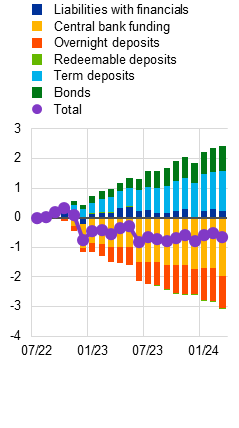 |
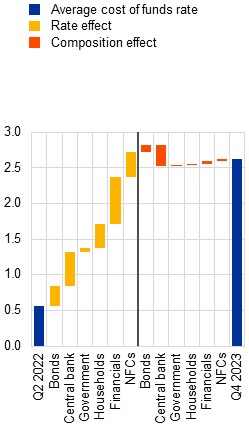 |
Sources: ECB (BSI, supervisory data) and ECB calculations.
Notes: Panel a: funding costs refer to average rates computed as interest expense/average stock of liability for the quarter. Panels a and c: based on a balanced sample of 80 euro area significant institutions. Panel b: based on all euro area banks.
The outlook for deposit rates remains uncertain, as new business deposit rates lose momentum while rates on the outstanding stock continue to rise. With policy rates expected to fall and the pass-through of changes in policy rates at similar levels to previous hiking cycles, term deposit rates are likely to decline going forward. The cost of new term deposits from NFCs has already reached a plateau, and rates offered on new term deposits from households already started falling in November 2023. This contrasts with the evolution of overnight deposit rates, for which the pass-through of policy rate increases remains compressed and which continue to rise slowly (Chart 3.6, panel a). Moreover, the share of overnight deposits remains high by historical standards and depositors continue to move funds into better remunerated term deposits. The implications for aggregate deposit rates are uncertain but if historic regularities from previous hiking cycles were to be repeated, deposit costs on the stock of outstanding deposits could, on average, increase further and lag the turn in the short-term interest rate cycle (Chart 3.6, panel b). This implies that deposit costs could become a headwind for bank profitability going forward, especially for those banks most dependent on deposit funding, such as those with small reserve ratios which have already seen larger changes in deposit rates over recent months.
Chart 3.6
The outlook for bank deposit rates is uncertain as market rates have likely peaked
|
a) New business deposit rates and betas |
b) Deposit rates and historic and market-implied overnight rates |
|---|---|
|
(Jan. 2022-Apr. 2024, percentages) |
(Jan. 2003-Feb. 2026; percentages) |
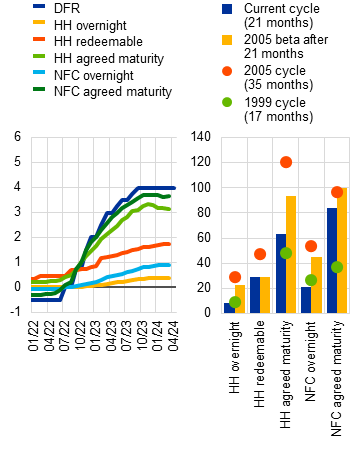 |
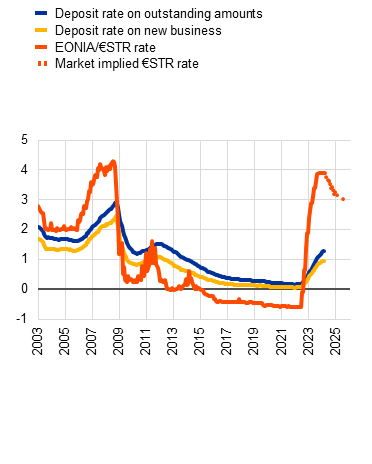 |
Sources: Bloomberg Finance L.P., ECB (MIR, BSI) and ECB calculations.
Notes: Panel a: deposit betas capture the percentage pass-through of the increase in the ECB’s deposit facility rate (DFR) to new business deposit rates since the start of the respective hiking cycles. All three deposit types – overnight, redeemable and term deposits – are considered in the right graph. Panel b: EONIA/€STR refers to EONIA minus 8 basis points until end-2021 and €STR afterwards.
Market-based funding costs have decreased since the previous issue of the Financial Stability Review was published, with credit spreads tightening considerably for the riskiest instruments. The cost of issuing new debt has risen significantly since the start of the monetary policy hiking cycle. Bond yields have, however, declined since the previous issue of the Financial Stability Review was published, benefiting from expectations of monetary policy rate cuts, which affect the yield curve, and strong bank fundamentals which supported a reduction in credit spreads (Chart 3.7, panel a). Despite some volatility in the market for covered bonds secured on commercial property loans in early 2024, there have been no spillovers to broader bank funding markets. Tighter credit spreads created a window of opportunity for some issuers to front-load issuance in early 2024. As a result, year-to-date cumulative issuance volumes are close to record levels (Chart 3.7, panel b). Market analysts expect the strong issuance activity to continue in 2024 – especially across covered and senior segments, which offer tighter pricing relative to other debt instruments – due to continued TLTRO repayments. In addition, with sizeable redemptions looming, issuance of AT1 instruments is also expected to increase considerably over previous years. By contrast, the issuance of senior non-preferred bonds is expected to slow, as banks have already built out MREL buffers to required levels.
Chart 3.7
Bank bond spreads have narrowed and issuance activity is close to record levels
|
a) Bank bond spreads |
b) Year-to-date euro area bank bond issuance volumes, to 7 May |
|---|---|
|
(3 Jan. 2022-7 May 2024, basis points) |
(2010-24, € billions) |
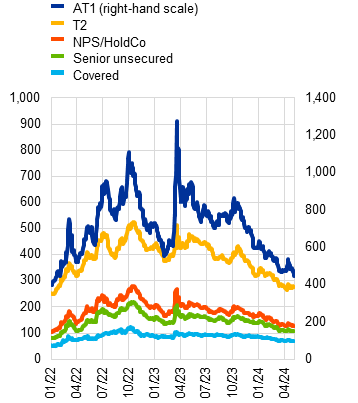 |
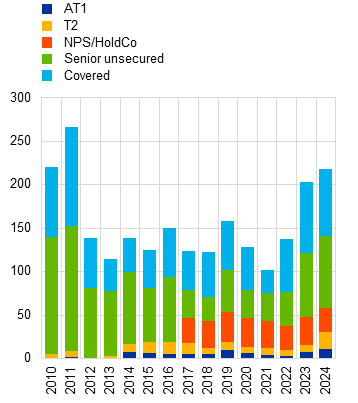 |
Sources: S&P Dow Jones Indices LLC and/or its affiliates, Dealogic and ECB calculations.
Notes: Based on a sample of euro area banks that issue euro-denominated bonds. AT1 stands for Additional Tier 1 securities; T2 stands for Tier 2 securities; NPS/HoldCo stands for senior non-preferred securities. Panel a: secondary market z-spreads. Panel b: year-to-date issuance volumes until 2 April across years and including issuance in all currencies.
Bank funding costs are expected to increase further, despite favourable developments in market funding conditions. With interest rates expected to decline, market-based short-term liabilities, such as those with financial institutions, should reprice downwards swiftly, reversing rate effects. By contrast, longer-term market-based liabilities, such as bonds, should continue to reprice at higher rates, given that outstanding bond rates are still below current market yields. In conjunction with the low and lagged pass-through of policy rates to deposit rates, overall funding costs might increase further, despite the easing of funding pressures.
3.3 Asset quality is slowly deteriorating, with commercial real estate and low provisioning levels most concerning
Non-performing loan (NPL) ratios remain close to historical lows in aggregate, but loans to micro firms and the commercial real estate (CRE) sector, and loans in countries with historically low NPL ratio levels, are starting to show mild signs of deterioration. NPL ratios remain broadly unchanged, apart from a recent slight increase for CRE portfolios (Chart 3.8, panel a). This development reflects the recent downturn in several CRE markets, in both the euro area and other advanced economies. NPL ratios also increased throughout 2023 for lending to micro firms, while declining slightly for lending to larger enterprises (Chart 3.8, panel b). This divergence in asset quality can be attributed to the effect of a cooling economy over the previous quarters, which disproportionately affects smaller firms. Banks in countries where NPL ratios have been lower historically are now showing an uptick in their NPL ratios, while banks established in countries with historically high NPL ratios continued to reduce their stock of legacy NPLs and maintained stable NPL ratios (Chart 3.8, panel c).[15]
Chart 3.8
NPL ratios started to increase slightly for loans backed by CRE, loans to micro firms and in countries with historically low NPL levels
|
a) NPL ratios by sector |
b) NPL ratios of NFC loans by firm size |
c) NPL ratios, by country group |
|---|---|---|
|
(Q1 2020-Q4 2023, percentages) |
(Q1 2020-Q4 2023, exposure-weighted NPL ratio of all NFC loans, percentages) |
(Q1 2020-Q4 2023, exposure-weighted NPL ratio, percentages) |
 |
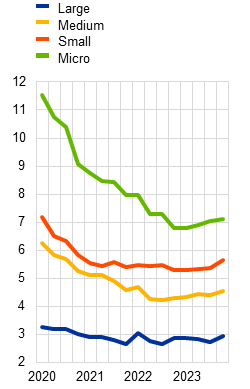 |
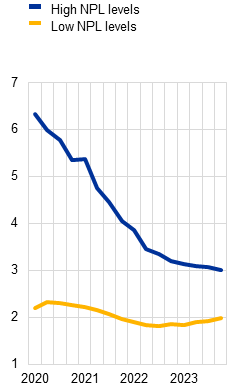 |
Source: ECB (AnaCredit, supervisory data).
Notes: Panel a: based on the full sample of significant institutions. Excludes loans held for sale, cash and cash balances at central banks and other demand deposits. CONS stands for consumer loans; CRE stands for commercial real estate; RRE stands for residential real estate. Panel b: AnaCredit follows the EU Commission standard classification for micro, small, medium and large firms. Panel c: based on the full sample of significant institutions. Excludes loans held for sale, cash and cash balances at central banks and other demand deposits. For country groupings, see footnote 26. Slovakia has only branches or subsidiaries with a parent in the euro area, which are not considered here.
Default rates have started to rise across various sectors from very low levels, while early arrears have increased, particularly for CRE and consumer loans. Default rates on corporate and retail exposures have been rising since the beginning of 2023, suggesting heightened risk in these sectors (Chart 3.9, panel a). Despite credit standards tightening and the cost of borrowing rising over the same period (Chapter 1 and Box 1), default rates remain at very low levels overall. There is a lagged relationship between economic growth and asset quality, and GDP growth is expected to strengthen in the second half of 2024, albeit at very different rates across countries (Chapter 1), in the light of which default rates are likely to deteriorate in countries with weak expected growth. Yet, the recent downturn in the CRE market is already affecting the performance of banks’ CRE loan portfolios. Loans less than one year in arrears continued to increase in 2023, albeit remaining below pre-pandemic levels (Chart 3.9, panel b). On the household side, the higher cost of living and borrowing is beginning to weigh on consumers, as seen in the growing share of consumer loans overdue by less than a year. Loans past due are nearing pre-pandemic levels, suggesting an uptick in financial stress (Chart 3.9, panel c). Looking forward, more defaults are to be expected in countries where weak economic growth forecasts materialise and in sectors, notably CRE, where the downturn intensifies.
Chart 3.9
Bank asset quality is gradually weakening, which is visible in rising default rates and arrears on consumer and CRE loans
|
a) Default rates, by sector |
b) Share of CRE loans that are less than one year past due |
c) Share of consumer loans that are less than one year past due and cost of borrowing |
|---|---|---|
|
(Q1 2019-Q4 2024, percentages) |
(Q1 2019-Q4 2023, percentages) |
(Q1 2019-Q4 2023, percentages) |
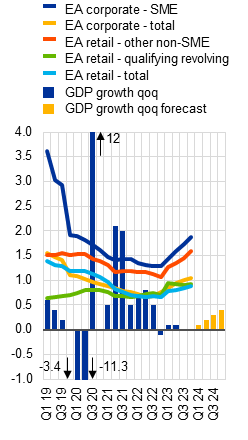 |
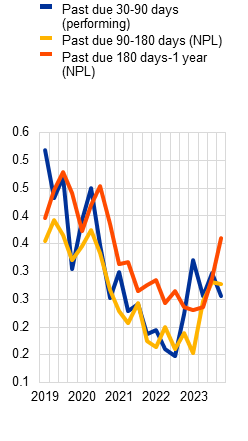 |
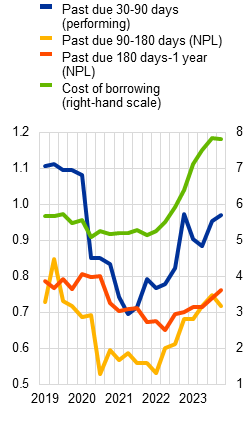 |
Sources: ECB (ECB staff macroeconomic projections for the euro area, March 2024, MIR, supervisory data).
Notes: Panel a: based on IRB-reporting significant institutions. Four-quarter trailing figures. Euro area exposures only. Panel b: based on the full sample of significant institutions; Panel c: based on the full sample of significant institutions. The cost of borrowing is measured as the lending rate on new consumer loans to households.
CRE lending has been at the centre of asset quality deterioration, although it remains a small part of banks’ overall lending portfolios. A handful of banks have recently experienced a significant deterioration in their CRE portfolios, evidenced by large net inflows to NPLs relative to the stock of performing CRE loans (Chart 3.10, panel a). While the situation varies considerably across banks, in aggregate CRE portfolios have experienced net inflows to NPLs over the last four quarters. The deterioration is particularly severe in the United States, whereas the performance of euro area CRE loans worsened only slightly (Chart 3.10, panel b). It is important to note that US CRE exposures are concentrated among a few banks, but euro area banks in aggregate have only limited exposures to US CRE (ten times smaller than euro area CRE exposures). Looking ahead, banks expect CRE loan demand to decline in the first two quarters of 2024, albeit much less so than in previous quarters, possibly indicating a gradual easing of the downturn in the CRE market (Chart 3.10, panel c). CRE loans remain a relatively small part of banks’ loan books, accounting for only around 8% of the total loans granted by significant institutions in the fourth quarter of 2023.
Chart 3.10
A few banks had large net inflows to NPLs on their CRE portfolios recently, while NPL ratios deteriorated on US exposures; banks expect CRE loan demand to decline further
|
a) Distribution of quarterly NPL net flows relative to the stock of performing loans for CRE loans across banks |
b) NPL ratio, by country/region of CRE exposure |
c) Credit standards, credit terms and loan demand for CRE loans |
|---|---|---|
|
(Q3 2020-Q4 2023, percentages) |
(Q1 2019-Q4 2023, percentages) |
(Q2 2020-Q2 2024, net percentages) |
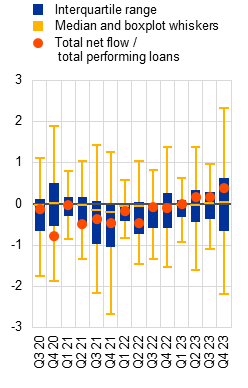 |
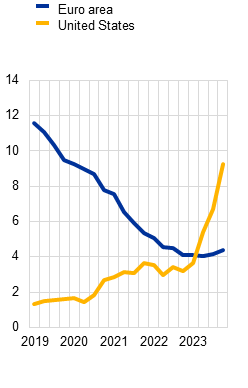 |
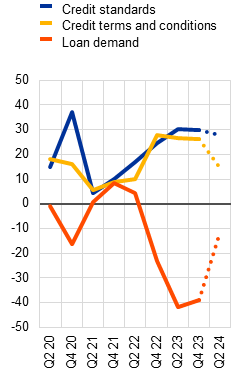 |
Source: ECB (supervisory data, BLS).
Notes: Based on the full sample of significant institutions. Panel a: excludes loans held for sale. Boxplot whiskers extend to the most extreme data point, which is no more than 1.5 times the length of the box away from the box. Panel b: loans and advances to NFCs collateralised by commercial immovable property. Panel c: each data point corresponds to the previous six-month period. The full lines represent the six-month backward-looking values, while the dotted lines show the six-month forward-looking value for Q2 2024. The net percentage of banks reporting a tightening of credit standards/terms and conditions is the share of banks reporting a tightening minus the share of banks reporting an easing, while the net percentage of banks reporting an increase in loan demand is the share of banks reporting an increase minus the share of banks reporting a decrease.
Banks’ muted provisioning flows could pose a risk if the deterioration in asset quality and credit risk continues. At the start of the pandemic, impairments due to credit risk eroded large parts of excess CET1 capital in the banking sector (Chart 3.11, panel a, left graph). If economic conditions, and collateral values in particular, trigger further impairments, this could substantially reduce excess CET1 capital. Furthermore, NPL coverage has been declining for all loan portfolios since 2018 (Chart 3.11, panel a, right graph) as banks have disposed of legacy NPLs with relatively high coverage ratios. Late and low provisioning could pose a risk if the economic environment deteriorates further. As NPL valuations reflect banks’ expected recoveries, which largely come out of collateral, the ongoing decline in loan impairment flows (Chart 3.11, panel b) seems inconsistent with falling property prices. The frequency at which banks revalue collateral varies substantially across the euro area[16] and the falling valuations suggest that provisioning can be expected to catch up − translating into a higher cost of risk − and may, in some cases, lead to erosion of capital.
3.4 Resilient banks amid subdued market valuations
Euro area banks continue to display resilience as liquidity positions and solvency ratios, supported by organic growth from high bank profitability, remain robust overall. The aggregate liquidity coverage ratio (LCR) of significant institutions in the euro area rose above 160% in the fourth quarter of 2023, despite the repayment of more than 80% of borrowed targeted longer-term refinancing operation (TLTRO) funds over recent quarters (Chart 3.12, panel a). The limited impact on the LCR from TLTRO repayments is partly because banks did not rely solely on excess reserves to meet TLTRO outflows but also reduced loans on demand[17], which do not qualify as high-quality liquid assets (HQLA) and thus have no impact on the LCR. Furthermore, TLTRO repayments released HQLA back into the banking system, which helped to support the LCR. Moreover, LCRs have also benefited from a small reduction in the expected net outflows thanks to the migration of deposits from sight to term accounts[18] (Chart 3.12, panel b). At 15.33% in the fourth quarter of 2023, the aggregate CET1 ratio of euro area banks was 33 basis points higher than one year ago, driven by an increase in retained earnings underpinned by strong bank profitability (Chart 3.12, panel c).[19]
Looking ahead, analysts expect bank profitability to decline slightly over the next two years, albeit to still comfortable levels above historic averages. Analysts expect the ROE of listed banks to fall from the present level of 11% to 10.7% and 10.4% in 2024 and 2025 respectively (Chart 3.13, panel a). This decline in bank profitability is expected to be driven by a mild reduction in net interest margins together with a slight rise in the cost of risk (Chart 3.13, panels b and c).
Chart 3.13
Analysts expect that bank profitability will decline mildly in 2024 and 2025 to still comfortable levels, as net interest margins narrow and cost of risk increases
|
a) Return on equity |
b) Net interest margin |
b) Cost of risk |
|---|---|---|
|
(percentages) |
(percentages) |
(percentages) |
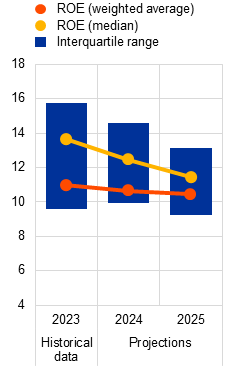 |
 |
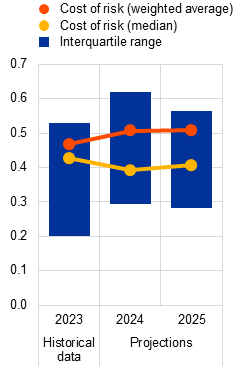 |
Sources: LSEG and ECB calculations.
Notes: Based on 37 listed banks with available analyst projections. All items refer to annual data. NIM stands for net interest margin and is computed as net interest income divided by total assets; cost of risk is computed as loan-loss provisions divided by total loans.
Euro area bank valuations lag those of some global peers, reflecting investor concerns about the durability of bank profits. The aggregate price-to-book ratio of euro area banks has improved in recent months and currently stands at 0.77 (Chart 3.14, panel a). Notwithstanding the recent improvement, the ratio remains notably below 1 and below that of some international peers, reflecting investor concerns about the ability of euro area banks to sustain current profitability levels durably given headwinds from weaker asset quality, lower revenues and cost of funding. In addition, one-off factors such as the introduction of bank levies and lingering structural problems across the industry may play a role. However, a track record of strong profitability and a low cost/income ratio are important determinants of increased price-to-book ratios at the individual bank level, suggesting that sustained bank profitability and efficiency provide a path to improved bank valuations (Chart 3.14, panel b).
Chart 3.14
Euro area bank price-to-book ratios continue to lag international peers but the relationship with bank profitability suggests a path to improving valuations
|
a) Price-to-book ratios of euro area banks and international peers |
b) Relationship between price-to-book ratios, bank efficiency and profitability |
|---|---|
|
(3 Jan. 2020-3 May 2024, ratios) |
(Q4 2023, percentages) |
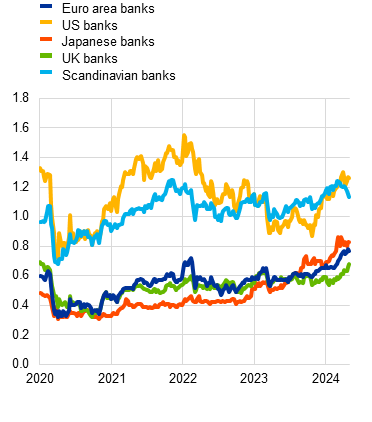 |
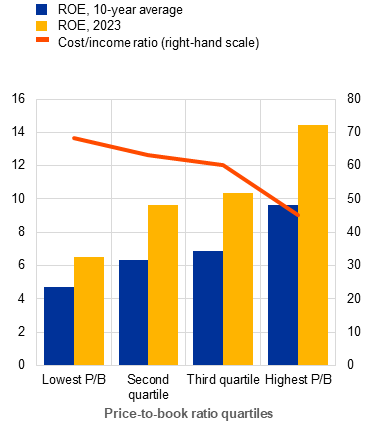 |
Sources: LSEG, Bloomberg Finance L.P., ECB (supervisory data) and ECB calculations.
Notes: Panel a: price-to-book ratios for Datastream banking sector indices. Panel b: calculations based on sample of 29 listed euro area banks. The cost/income and price-to-book ratios are as of Q4 2023.
Box 4
Non-bank financial intermediaries as providers of funding to euro area banks
Around 20% of euro area banks’ funding is provided by the non-bank financial intermediation (NBFI) sector. Compared with usually more stable retail sources, NBFI funding mainly consists of market-based instruments, such as bonds and repurchase agreements, with the latter being particularly sensitive to stress events.[20] Leveraging on previous analysis,[21] this box investigates the role of the NBFI sector in providing funding to banks. In this context, the analysis assesses risks to banks in the event of sudden outflows from the NBFI sector with potential knock-on effect on their ability to finance banks. Specifically, we evaluate whether banks can replace their NBFI funding by tapping different instruments or sectors.
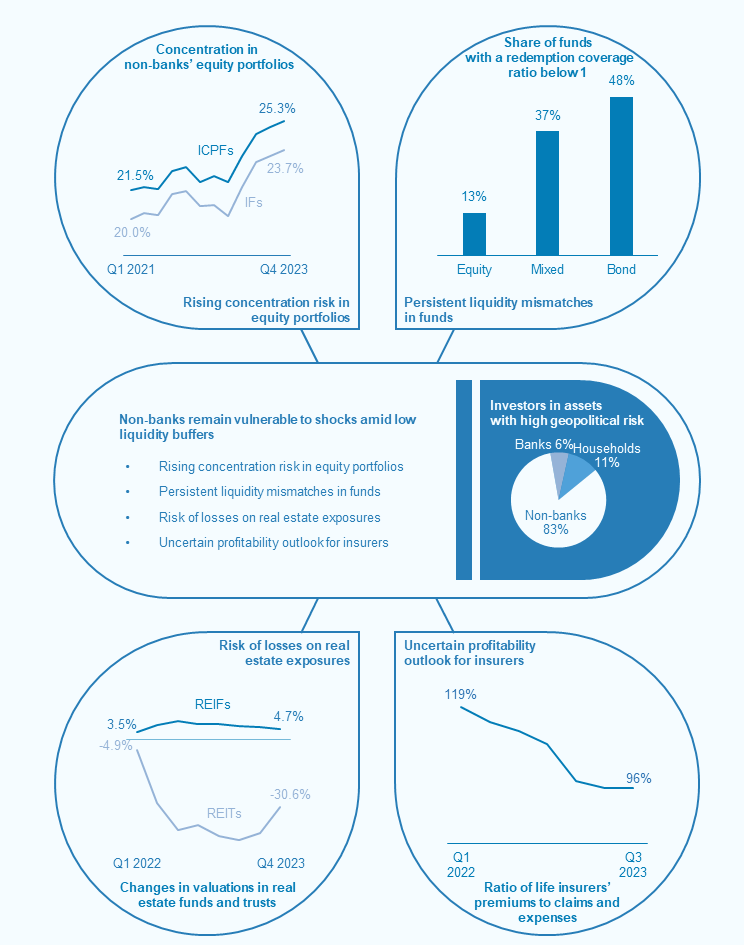
4.1 Fragile macro-outlook may still test non-banks’ resilience
The non-bank financial intermediation (NBFI) sector in the euro area has remained resilient overall and benefited from rising investment income in 2023. Euro area non-banks have continued to prove resilient in a challenging macro-financial environment (Chapter 1), further adjusting their portfolios towards fixed income securities in the context of a higher interest rate environment. Higher interest rates have also resulted in rising investment income from debt securities. This has allowed non-banks to generate increasing returns while simultaneously reducing their exposures to comparatively riskier asset classes. Although aggregate income from both fixed- and variable-rate debt securities has improved for the NBFI sector (Chart 4.1, panel a), some sub-sectors, such as insurance corporations, have only benefited marginally to date (Section 4.3).
Chart 4.1
Higher interest rates have pushed up non-banks’ investment income from debt securities, but have so far not translated into higher liquidity buffers
|
a) Euro area NBFI sector investment income from debt securities |
b) Euro area NBFI sector cash and liquid asset holdings |
|---|---|
|
(Q1 2021-Q4 2023; € billions, percentages) |
(Q1 2021-Q4 2023, percentages of total assets) |
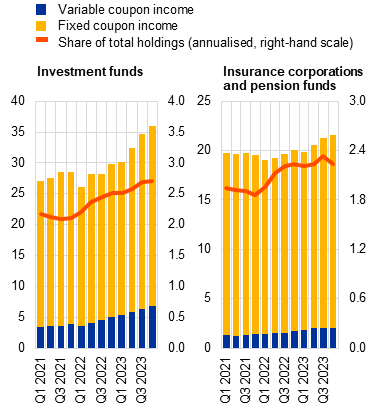 |
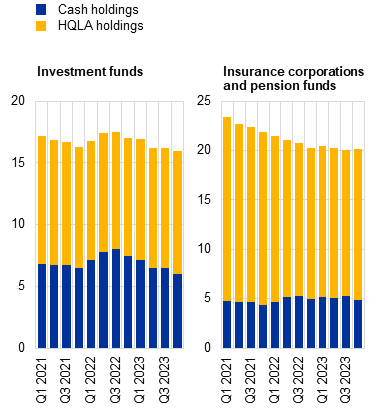 |
Sources: ECB (ICB, IVF, PFBR, SHS, CSDB) and ECB calculations.
Notes: Panel a: annualised income as a share of nominal holdings. Fixed-coupon debt securities include zero coupon bonds. Panel b: HQLA (high-quality liquid assets) are defined as HQLA Level 1 securities.
Liquidity buffers have declined further, despite higher returns on more liquid asset classes, limiting the capacity of the NBFI sector to absorb shocks. The cash and liquid asset holdings of euro area non-banks remain low in aggregate, exposing the NBFI sector to liquidity risks (Chart 4.1, panel b). This represents a structural vulnerability in open-ended investment funds as it increases the risk of forced asset sales in the event of an unexpected rise in shareholder redemptions (Section 4.2). Sudden liquidity needs may also arise from margin calls on derivative exposures (Box 5), especially for interest rate derivatives amid elevated interest rate volatility (Chapter 2). Ensuring adequate preparedness against spikes in demand for liquidity therefore remains a key element in preserving financial stability in the NBFI sector (Chapter 5).
NBFI portfolio valuations have been supported by improved market sentiment, while equity exposures have become more concentrated. Improved financial market sentiment in late 2023 and early 2024, especially in US equity markets (Chapter 2), has helped to push up asset valuations in the NBFI sector. Over the course of 2023, euro area non-banks’ holdings of listed shares issued by non-financial corporations became more concentrated, reflecting both a reduction in overall equity portfolio size and an increasing market footprint of a few large issuers. The share of the 25 largest issuers held among non-financial equities has risen to 24% for investment funds and 25% for insurance corporations and pension funds (ICPFs) (Chart 4.2, panel a). By contrast, portfolio concentration is relatively stable or declining for non-financial debt holdings. Equity portfolios may therefore be increasingly vulnerable to idiosyncratic risk, especially in investment funds, where holdings are additionally concentrated in US-based technology firms (Section 4.2). As such, sudden drops in the share price of one or a few individual companies could trigger significant portfolio losses and result in fund outflows, with the potential for spillovers to the wider financial system.
Chart 4.2
Non-banks’ equity portfolios have become more concentrated while the sector also remains exposed to geopolitical risk
|
a) Euro area NBFI sector investments allocated to the top 25 non-financial debt and equity issuers held |
b) Euro area NBFI sector holdings, by rating and exposure to geopolitical risk |
|---|---|
|
(Q1 2021-Q4 2023; € trillions, percentages) |
(Q4 2023; percentages, € trillions) |
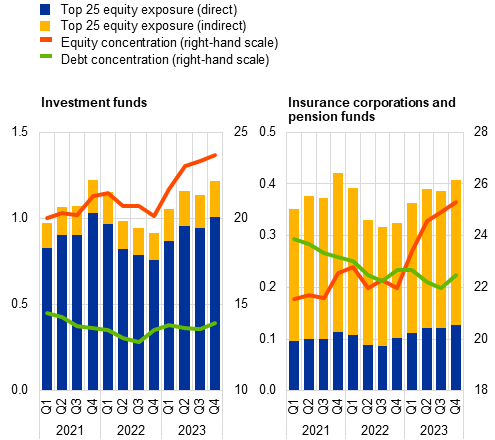 |
 |
Sources: ECB (SHS, CSDB) and ECB calculations.
Notes: Panel a: equities are defined as listed shares issued by non-financial corporations. Indirect exposures relate to assets held though investment fund shares. Panel b: levels of geopolitical risk exposure are defined at the sector level using the methodology outlined in Special Feature A in this issue of the Financial Stability Review. The worst available rating is used to allocate holdings to credit risk segments.
Downside risks to asset valuations remain, especially for NBFI portfolios with high credit risk, a focus on real estate or exposures sensitive to geopolitical risk. While the overall outlook has improved over the past six months, the macroeconomic environment remains characterised by elevated uncertainty (Chapter 1). Pockets of vulnerability therefore remain in different parts of the euro area NBFI sector, which may still face valuation losses. While a risk of rising corporate defaults may impair asset quality for a wide range of NBFI entities, a further downturn in real estate markets may particularly affect valuations of real estate investment funds or ICPFs with sizeable real estate holdings (Sections 4.2 and 4.3). Investment portfolios held by the euro area NBFI sector are also sensitive to increases in geopolitical risk, and tensions related to ongoing conflicts and upcoming elections may also indirectly spill over to the sector (Special Feature A). The risk of potential valuation losses in this context could thereby be amplified by elevated credit risk in a significant share of asset holdings with medium or high levels of sensitivity to geopolitical risk (Chart 4.2, panel b).
4.2 Funds face risks from concentrated portfolios, real estate and low liquidity
Euro area investment funds’ portfolios have shifted towards safer assets, but concerns remain over funds’ support to the euro area real economy. Over the last two years, euro area investment funds have rebalanced their portfolios’ holdings away from equities towards debt securities, in particular sovereign and financial bonds (Chart 4.3, panel a). This shift in funds’ securities holdings highlights a de-risking trend. At the same time, concerns remain about the support given to the euro area economy by investment funds through the equity markets, which may point to a tightening in financing conditions for euro area corporates. Indeed, cumulative flows of euro area-domiciled equity funds into euro area stocks have been negative for the last two years (Chart 4.3, panel b). At the same time, flows into US stocks have been steadily rising. These observed flow dynamics reflect the diverging growth expectations between the two economies (Chapter 1, Chart 1.2, panel a), while the declining flows towards emerging Asian markets (since the second half of 2023) might be echoing the rising geopolitical tensions.
Concentration in the non-financial equity portfolio of euro area investment funds remains high and tilted towards US issuers. The share of holdings in the top 25 issuers rose from 20% in the fourth quarter of 2022 to 24% in the fourth quarter of 2023, following a trend common to the rest of the non-bank sector (Section 4.1, Chart 4.2, panel a). Within this share, portfolio concentration has shifted significantly from euro area issuers towards US issuers over the last decade (Chart 4.3, panel c). In terms of sector, technology companies account for more than 60% of the top 25 issuers as of the fourth quarter of 2023. These factors expose the euro area investment fund sector to adverse developments in the US economy and to potential bubbles in the technology sector (Chapter 2, Chart 2.6).
Chart 4.3
Euro area investment funds are reducing their equity exposures towards the euro area economy and increasing their portfolios’ concentration towards US and tech sectors
|
a) Euro area IF transactions of security portfolios, by security type and issuer sector |
b) Cumulative flows of euro area-domiciled equity funds into stocks, by region |
c) Exposure of euro area IFs to NFC equity of the top 25 issuers, by country and technology sector |
|---|---|---|
|
(Q1 2022-Q4 2023, € billions) |
(3 Jan. 2022-7 May 2024, country flows as percentages of total country allocation) |
(Q4 2013-Q4 2023; left-hand scale: percentages, right-hand scale: € trillions) |
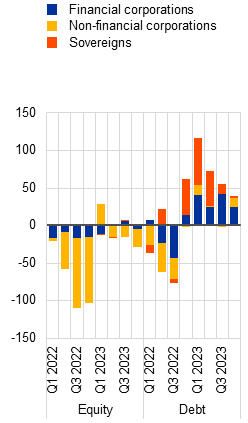 |
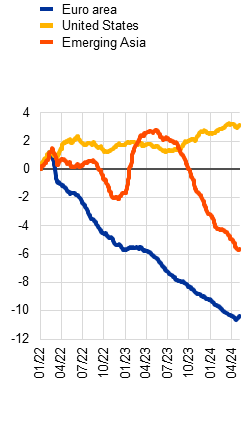 |
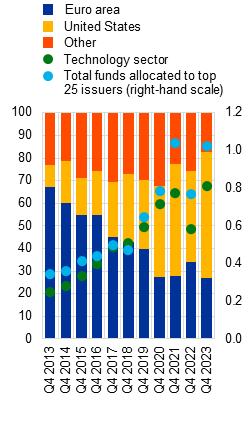 |
Sources: ECB (CSDB, SHS), EPFR Global and ECB calculations.
Notes: IFs stands for investment funds. Panel b: country flows combine fund flows and country allocations to show total flows into a specific country. Country allocation is the average fund’s exposure to a country, while total country allocation is the total flows into a specific country.
Corrections in real estate markets might challenge the liquidity preparedness of real estate investment funds (REIFs). Euro area REIFs might face losses from real estate market corrections, as hinted at by the declining market capitalisation of real estate investment trusts (REITs)[22]. The net asset value of euro area REIFs has remained stable, despite a significant correction in the underlying commercial real estate market, which suggests that valuation losses have not yet been fully priced in (Chart 4.4, panel a). Such losses might trigger redemption requests for REIFs, putting stress on their cash buffers. Indeed, cumulative quarterly flows into euro area open-ended REIFs have been declining since the start of the monetary policy tightening cycle and turned negative as of the third quarter of 2023. Moreover, the median cash buffer has also gone down (Chart 4.4, panel b). Insufficient cash buffers could lead to forced asset sales, particularly if the downturn in the real estate market were to persist or intensify.
Chart 4.4
Corrections in real estate markets and low liquidity buffers could be a test for the resilience of euro area investment funds
|
a) Cumulative changes in net asset value of euro area REITs and REIFs |
b) Euro area open-ended REIF cash buffers and net flows |
c) Redemption coverage ratio, by type of euro area investment fund |
|---|---|---|
|
(Q1 2022-Q4 2023, cumulative percentage change in total net asset value) |
(Q2 2022-Q4 2023, percentages; left-hand scale: cash as a share of total net asset value, right-hand scale: net flows as a share of total net asset value) |
(Q4 2019-Q4 2023, ratio) |
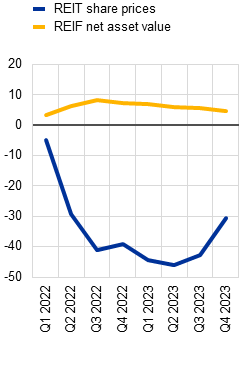 |
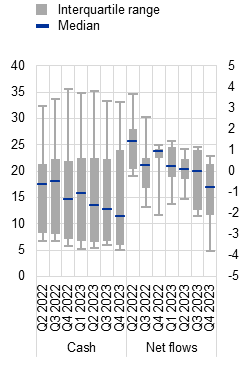 |
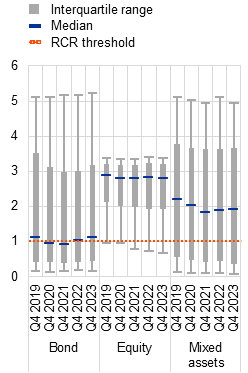 |
Sources: ECB (IVF), Bloomberg Finance L.P., LSEG Lipper and ECB calculations.
Notes: REITs stands for real estate investment trusts; REIFs stands for real estate investment funds. Panel b: the distributions are from country aggregate statistics of open-ended REIFs. The countries included in the sample are Germany, Ireland, France, Luxembourg, the Netherlands, Austria, Portugal and Slovakia. The whiskers refer to the 10th and 90th percentiles. Panel c: the redemption coverage ratio (RCR) measures investment funds’ resilience to redemption shocks, following the methodology set out in the box entitled “Assessing liquidity vulnerabilities in open-ended bond funds: a fund-level redemption coverage ratio approach”, Financial Stability Review, ECB, November 2023. The RCR is obtained by dividing the value of fund-level HQLA stock by net outflows experienced in a severe but plausible scenario lasting 30 days. The box plots display the distribution per fund group of the resulting fund-level RCRs. The whiskers refer to the 10th and 90th percentiles.
Liquidity risks and leverage continue to be a challenge for the euro area investment fund sector. The redemption coverage ratio (RCR) shows that overall the sector is in a position to meet liquidity needs from outflows. However, the ratio has deteriorated since the fourth quarter of 2019, and pockets of vulnerabilities lie in the lower tails of the RCR distributions, especially for certain types of funds with comparatively high liquidity mismatches (Chart 4.4, panel c). Liquidity shocks might come from the derivatives market, where the ability of some funds to meet margin calls has deteriorated over the last two years (Box 5). Furthermore, excessive leverage remains an issue for the investment fund sector, especially when combined with low liquidity buffers and high credit risk. These considerations highlight the need to strengthen the resilience of investment funds from a macroprudential perspective (Chapter 5 and Box 6).
Emerging risks from private market funds and geopolitical tensions might pose new challenges to the euro area’s financial stability. Although still limited in size, the euro area private market fund sector has been growing significantly over the last two decades (Chart 4.5, panel a). Despite demonstrating a relatively low risk profile overall, private markets have concentrated exposures, opaqueness and uncertain resilience in a higher interest rate environment that are a source of concern for financial stability (Special Feature C). Further worries stem from geopolitical tensions. On the one hand, direct exposures of euro area investment funds to countries badly affected by geopolitical risk are limited and decreasing (Chart 4.5, panel b). On the other hand, the threat of adverse geopolitical developments may still spread to the sector indirectly, increasing uncertainty and undermining investor confidence (Special Feature A).
Chart 4.5
An expanding private market fund sector and exposures to geopolitical risk might yield new challenges for euro area financial stability
|
a) Size and composition of the euro area private market fund sector |
b) Euro area investment funds’ exposures to countries subject to geopolitical risk |
|---|---|
|
(2000-23; left-hand scale: € trillions, right-hand scale: percentages) |
(Q1 2021-Q4 2023; left-hand scale: € billions, right-hand scale: percentages) |
 |
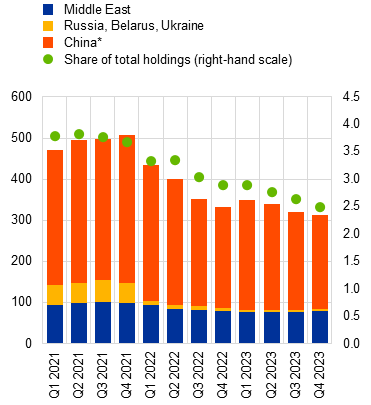 |
Sources: ECB (IVF, SHS, CSDB), PitchBook Data, Inc. and ECB calculations
Notes: Panel a: data for 2023 refer to Q3. Private equity funds include venture capital funds; real asset funds include real estate, infrastructure and natural resources. Panel b: *data for China include Hong Kong SAR and Taiwan.
Box 5
Assessing the liquidity preparedness of investment funds to meet margin calls in derivatives markets
Recent episodes of liquidity stress in financial markets have highlighted the need to monitor the liquidity preparedness of funds to meet margin calls in the derivatives market.[24] Spikes in margin calls can lead to liquidity strains in the investment fund sector and to procyclical asset sales during times of market stress. This scramble for liquidity can spread to other parts of the financial system and the real economy, potentially transforming liquidity stress at the individual entity level into a system-wide issue, as happened during the market turmoil in March 2020 and the UK gilt crisis in September 2022.[25] This box proposes four novel indicators of fund-level liquidity preparedness to meet margin calls, aimed at identifying potential pockets of vulnerabilities that may require higher cash buffers and/or more diversified high-quality liquid assets (HQLA).[26]
4.3 Strong solvency but uncertain profitability outlook for insurers
Euro area insurance corporations remain resilient overall, although profitability challenges remain, especially for life insurers. Insurers’ Solvency Capital Requirement (SCR) coverage ratios remained well above the regulatory minimum of 100% and increased marginally in 2023 (Chart 4.6, panel a).[27] However, the profitability outlook remains less certain. Life insurers saw the ratio of premiums written to claims incurred and acquisition expenses decline slightly in 2023, as claims increased relative to previous years (Chart 4.6, panel b). Limited growth in demand for new policies is most likely attributable to worsening real household incomes and the availability of higher returns from other asset classes.[28] However, positive macroeconomic outcomes and increasing returns on life insurance products could support growth in underwriting going forward.
Chart 4.6
Insurers’ solvency remains strong, but life insurers’ underwriting profitability has fallen
|
a) SCR ratios of large euro area insurance groups |
b) Euro area life insurers’ ratio of premiums to claims and expenses |
|---|---|
|
(Q1 2021-Q3 2023, percentages) |
(Q1 2021-Q3 2023; € billions, percentages) |
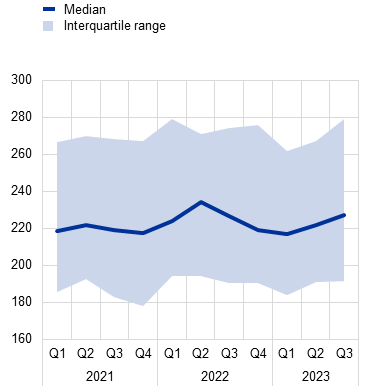 |
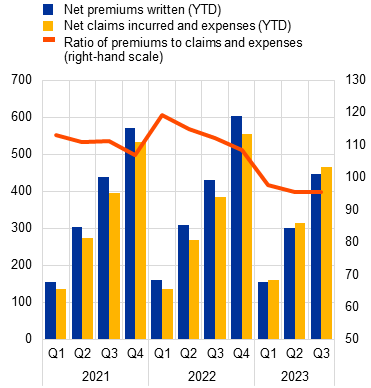 |
Sources: ECB (LIG) and ECB calculations.
Notes: Panel a: the SCR coverage ratio is defined as eligible own funds divided by SCR. Panel b: the ratio is cumulative over the period Q1 to Q4 of each year for large euro area insurance groups’ life business.
The period of ultra-low interest rates coming to an end may help ICPFs become more resilient in the medium term, although it is still important for them to strengthen their liquidity preparedness. Insurance corporations and pension funds (ICPFs) generally benefit from higher interest rates, given their negative duration gaps.[29] Additionally, rising rates may also increase their demand for higher-quality bonds, which may help to lower credit risk. At the same time, any sharp increase in financial market volatility or interest rates could expose those ICPFs that use interest rate derivatives to large margin calls. Recent stress events, such as the March 2020 market turmoil and the UK gilt market episode, demonstrate how liquidity pressures faced by ICPFs can propagate stress across the wider financial system. This underscores how important it is for ICPFs to strengthen their liquidity preparedness to meet margin calls (Chapter 5).
Additionally, insurers have seen their investment income remain relatively unchanged despite higher interest rates. Income from bond investments increased marginally in 2023, whereas the annual yield on insurers’ bond portfolios remained at around 2% (Chart 4.7, panel a). This reflects the insurers’ large share of long-dated bond holdings acquired during a period of ultra-low interest rates and the prevalence of fixed-rate coupons (Section 4.1). In the short term, any fall in interest rates could further depress investment income. In the longer term, however, insurers are still likely to benefit from improved returns as they gradually roll over their portfolios at higher yields than in the past. Additionally, ICPFs have increased their allocation to alternative, typically higher-yielding assets, such as private equity, private credit and real estate. These may improve investment returns while also posing risks (Special Feature C).
Insurers may face revaluation losses on real estate investments, which could weigh on profitability. During the period of ultra-low interest rates that prevailed until 2022, ICPFs significantly increased their holdings of less liquid assets, especially real estate.[30] This mainly reflects indirect investment in euro area real estate through REIF shares, other equities and debt securities (Chart 4.7, panel b). The ongoing correction in commercial real estate markets (Chapter 1) could result in losses on these exposures, which would weigh on insurers’ profitability. Further corrections could increase redemption pressures and the potential for forced sales by open-ended REIFs (Section 4.2), with potential losses for their investors, including ICPFs. Consequently, interconnectedness in commercial real estate exposures across the financial system warrants continued monitoring.
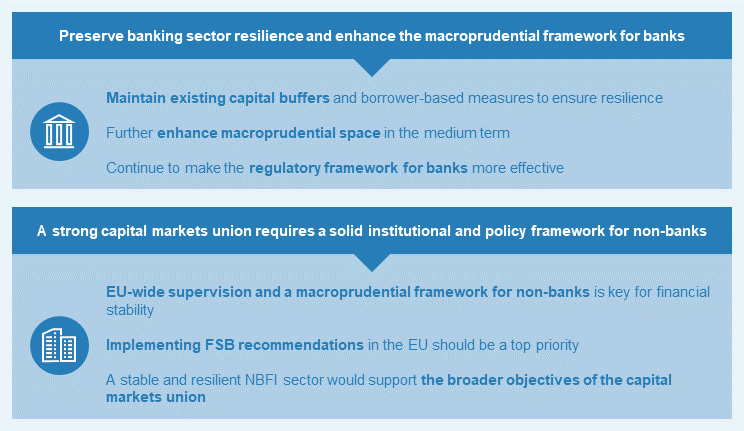
5.1 Preserve banking sector resilience and enhance the macroprudential framework for banks
In recent years, the euro area banking sector has proven its resilience during a series of adverse shocks, thanks in part to decisive and comprehensive macroprudential action. Since the pandemic, rising capital buffers have further boosted the banking sector’s resilience to shocks and have helped to create additional macroprudential space.[31] They have complemented the existing borrower-based measures that have been effective in bolstering borrowers’ resilience, as demonstrated by the limited deterioration in mortgage credit quality seen so far.
Maintaining existing macroprudential buffer requirements remains a priority, with a view to ensuring that banks are resilient to potential headwinds. Notwithstanding the tentative improvements seen in the financial stability outlook, global macroeconomic prospects are surrounded by a high level of uncertainty and tail risks remain (Chapter 1). Moreover, asset quality is slowly deteriorating, with commercial real estate and low provisioning levels of most concern (Chapter 3). In this context, and in the absence of signs of widespread losses and credit supply constraints arising from bank capital, it is advisable to maintain existing capital buffer requirements in case they are needed in the event of a deterioration in banking sector or macro-financial conditions. Borrower-based measures should continue to fulfil their role as structural backstops and should be maintained to ensure that lending standards remain sound.[32] Furthermore, the ECB has continued to highlight its concerns over the implications of initiatives to impose extraordinary taxes on credit institutions in the interests of financial stability.[33] Not only may such diverse, ad hoc fiscal actions create uncertainty for banks and their investors, they may also make it harder for banks to build up further capital buffers at a time when ensuring a sound capital base is essential.
Over the medium term, further enhancing macroprudential space through releasable buffers is a robust policy strategy for enhancing the resilience of the banking sector. Since the pandemic, authorities in the banking union have increased the amount of releasable buffers through more active use of the countercyclical capital buffer (with several authorities activating a positive neutral rate for this buffer) or the systemic risk buffer. By increasing the macroprudential space available to support the banking sector in the event of (potentially severe) shocks that could occur at any phase of the cycle, a higher amount of releasable capital buffers enables macroprudential authorities to act countercyclically in a more effective manner (Chart 5.1, panel a). More widespread use of releasable buffers has resulted in a noticeable increase in macroprudential space, with the total amount of releasable buffers in the banking union reaching around €82 billion,[34] although some jurisdictions do not have any releasable buffers in place. Where favourable conditions limit the likelihood of procyclical effects, it is therefore desirable to broaden macroprudential space still further, for example through the implementation of a positive neutral rate for the countercyclical capital buffer. The economic cost of recent increases in the buffer requirements has been low because of banks’ existing capital headroom and robust profitability (Chart 5.1, panel b).[35]
Chart 5.1
Macroprudential space enhances the effectiveness of countercyclical macroprudential action while favourable banking sector conditions mitigate the economic costs of increasing capital requirements
|
a) Impulse responses of GDP to a recessionary shock for different levels of releasable capital buffers available |
b) Impact on credit growth of a 1 percentage point increase in the combined buffer requirement for different levels of capital headroom |
|---|---|
|
(x-axis: quarters after shock; y-axis: percentage deviations from the steady state) |
(x-axis: capital headroom as a percentage of risk-weighted assets; y-axis: credit growth in percentage points) |
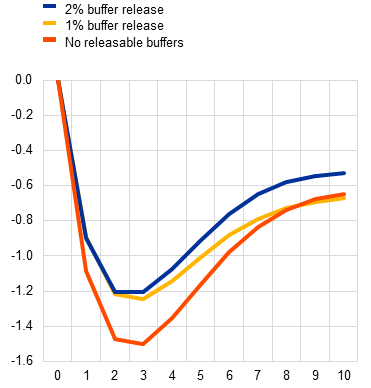 |
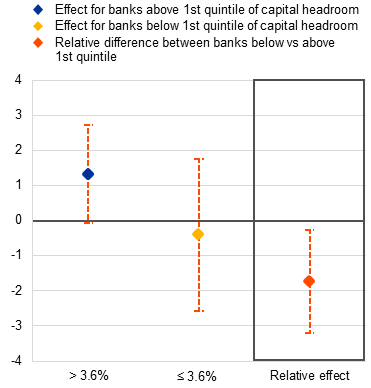 |
Sources: ECB (AnaCredit, supervisory data), ECB calculations and national notifications.
Notes: Panel a: a higher share of releasable buffers provides macroprudential authorities with greater leeway to respond to severe shocks. Simulations were performed using the 3D DSGE model calibrated for the euro area*. The chart shows the impulse responses of GDP to a mix of negative housing and physical capital price shocks triggering a (peak) -1.5 percentage point decline in GDP in the baseline scenario with no releasable capital buffers (red line). The yellow line depicts the GDP response when the macroprudential authorities fully release the available 1% capital buffer, while the blue line represents the GDP response when the macroprudential authorities fully release the available 2% capital buffer. The exercise assumes that (i) capital buffers are fully usable and are not constrained by other parallel requirements; and (ii) banks fully use the released buffer, decreasing their capital ratios in line with the amount of the release. Panel b: higher capital headroom limits the cost of capital buffer increases. The chart shows the impact on credit growth of a 1 percentage point increase in the combined buffer requirement (CBR) for different levels of capital headroom (defined as the distance to the CBR) based on bank-firm level panel regressions using a sample of almost 15 million observations for 2,088 euro area banks (significant institutions and less significant institutions) over the period from Q2 2021 to Q2 2023. The econometric model also includes a set of bank-level controls, bank fixed effects and firm-quarter dummies. The red lines indicate the 90% confidence intervals around the point estimate. The blue diamond represents the impact on credit growth for banks above the first quintile of the capital headroom distribution, while the yellow diamond represents the impact on credit growth for banks below the first quintile of the capital headroom distribution. The red diamond represents the estimated differential impact between banks with capital headroom below the 1st quintile of the capital headroom distribution (3.6%) and those with capital headroom above 3.6%. Confidence intervals overlapping at zero indicate that the effect on credit growth is not statistically significant.
*) See Mendicino, C., Nikolov, K., Suarez, J. and Supera, D., “Bank capital in the short and in the long run”, Journal of Monetary Economics, Vol. 115, November 2020, pp. 64-69.
In this context, further progress on regulatory initiatives aimed at improving the efficiency and effectiveness of the EU macroprudential framework remains a priority. The ECB welcomes the European Commission’s report on the review of the EU macroprudential framework and strongly supports proposals aimed at enhancing the effectiveness and consistency of the macroprudential toolkit, simplifying macroprudential coordination mechanisms and broadening macroprudential space.[36] In this regard, promoting the build-up of releasable buffers, including through a more flexible use of the countercyclical capital buffer, and enhancing their usability are of key importance. While the full applicability of final targets for minimum requirements for own funds and eligible liabilities (MREL) as of 2024 will significantly improve the resolvability of EU banks, it is important to assess the resulting implications for capital buffer usability arising from parallel capital requirements.[37] This will warrant enhanced information-sharing between macroprudential and resolution authorities on MREL targets.[38] The ECB also reiterates its call for a more consistent use of macroprudential instruments across jurisdictions, particularly of the sectoral SyRB, to promote the coherent treatment of systemic risks across countries.
Recent initiatives by the Basel Committee and the implementation of the final Basel III reforms in the EU will further enhance the effectiveness of macroprudential policy and contribute to financial stability. In April 2024 the Basel Committee published its revised Basel Core Principles for Effective Banking Supervision, emphasising the importance of close cooperation between supervisory and macroprudential authorities and reflecting regulatory and supervisory developments since the last revision.[39] In the EU, the final Basel III reforms are being introduced via the EU banking package, which is currently being adopted by the European Parliament and the EU Council. The reforms will become effective on 1 January 2025 and will further bolster the resilience of the EU banking system, enhance the supervisory toolkit and address climate-related and other sustainability risks.
5.2 Progress towards a capital markets union requires a solid institutional and policy framework for non-banks
Non-banks play a pivotal role in the development of capital markets but, unlike banks, they largely lack a macroprudential framework. As the euro area non-bank financial intermediation (NBFI) sector has grown considerably in size since the global financial crisis, it has become an increasingly important source of funding for the real economy.[40] By reducing reliance on bank-based financing, this expansion has helped to diversify the sources of financing and contributed to the development of capital markets. However, parts of the NBFI sector exhibit significant vulnerabilities (Chapter 4), and the institutional and policy framework largely lacks a macroprudential perspective.
Enhancing the macroprudential framework for non-banks could help ensure that they provide a stable source of financing through the financial cycle – a key feature for building a strong capital markets union. But there is more work to be done to achieve this goal, as illustrated by several periods of stress in recent years. For example, the March 2020 market turmoil and the UK government bond (gilt) market stress in 2022 brought to the fore structural vulnerabilities in non-banks, such as excessive leverage, inadequate liquidity preparedness, liquidity mismatches and interconnectedness.[41] Against this background, the ECB welcomes the European Commission’s plan for a targeted consultation on macroprudential policies for the NBFI sector in 2024.[42]
A comprehensive macroprudential framework for non-banks should be based on several key principles. First, a system-wide perspective is needed to address the vulnerabilities in the NBFI sector holistically. This involves taking into consideration interdependencies between non-banks and linkages with the banking sector and the real economy. In the March 2020 market turmoil, for instance, forced asset sales by non-banks amplified the adverse market dynamics and liquidity risk spilled over to short-term debt securities issued by banks and firms through money market funds (MMFs).[43] Second, a macroprudential framework should also focus on building up resilience ex ante rather than relying on ex post measures. This would help to prevent stress from emerging in non-banks so as to ensure that, even in times of market stress, they can provide a resilient source of funding. Finally, given the varied nature of the NBFI sector, the macroprudential framework should allow for policies to be tailored to the diverse set of entities and activities involved.
In this regard, the Financial Stability Board (FSB) has issued recommendations that are crucial for the EU to implement. Implementing these regulations would increase resilience and foster a level playing field across the NBFI sector, both within the EU and globally. The level playing field is needed to mitigate the risk of cross-border fragmentation, regulatory arbitrage and/or business reallocation, as well as risks stemming from globally interconnected entities and activities.
The first concern is reform of MMFs. Overall, the progress made in implementing the international standards for MMFs developed in response to the March 2020 market turmoil has been uneven across jurisdictions.[44] Authorities in the United States recently raised the liquidity requirements for MMFs, requiring them to hold weekly liquid assets of at least 50% of a fund’s total assets.[45] In the United Kingdom, the authorities recently proposed the same requirements in a public consultation. By contrast, in the euro area these requirements range from 15% to 30%, depending on fund type. This leaves MMFs domiciled in the euro area less resilient to liquidity shocks in comparison. Moreover, for euro area MMFs which invest in assets denominated in foreign currencies (e.g. GBP-denominated MMFs domiciled in Ireland), rules that diverge globally can create opportunities for regulatory arbitrage, while weaker resilience could also trigger spillovers to funding markets in jurisdictions outside the euro area.[46],[47]
Second, the FSB recently published its revised recommendations on liquidity mismatch in open-ended funds (OEFs).[48] These recommendations aim to better align fund redemption terms with the liquidity of a fund’s asset portfolio and to enhance the availability and use of liquidity management tools. This would enable OEFs to pass on to redeeming investors the explicit and implicit costs of selling assets under both normal and stressed market conditions.[49] It should, in turn, reduce first-mover advantage and disincentivise procyclical investor redemptions.
Implementation of the FSB’s recommendations for OEFs should continue in the EU, and the effectiveness of the reforms should be assessed in due course. In the EU, amendments to the regulatory frameworks for funds were published in November 2023 and are expected to enter into force in the first quarter of 2026.[50] Among other things, this new legislation aims to promote greater availability and use of liquidity management tools, including the suspension of redemptions, redemption gates, the extension of notice periods, redemption fees, swing pricing, dual pricing, anti-dilution levies, redemptions in kind and side pockets. Going forward, the extent to which these reforms will be effective in reducing vulnerabilities arising from liquidity mismatch in OEFs remains to be seen. It should also be borne in mind that the European Securities and Markets Authority (ESMA) is still in the process of developing more detailed standards on the implementation of these liquidity management tools.
The FSB is also working on recommendations which would enhance liquidity preparedness across the NBFI sector to meet margin and collateral calls. Specifically, it recently published a consultation paper proposing eight policy recommendations. These cover non-banks’ liquidity risk management and governance, their stress testing and scenario design, and their collateral management practices, all of which aim to mitigate liquidity risks arising from spikes in margin and collateral calls.[51] The FSB’s recommendations apply to a wide range of non-banks and cover both centrally and non-centrally cleared derivatives and securities markets. Because of the important interlinkages between liquidity preparedness and transparency, the recommendations are being developed at the same time as other international recommendations for good margining practices in centrally and non-centrally cleared markets.[52] For instance, if central counterparties were required to provide margin simulation tools to clearing members and clients (typically non-banks), this could provide significant support to non-banks carrying out liquidity stress tests.
Once finalised, the recommendations on margin and collateral calls should be swiftly implemented in the EU across a wide range of non-banks. Box 5 suggests that over 15% of euro area OEFs and exchange-traded funds do not appear to be adequately prepared to cope with potential spikes in margin calls. Based on previous studies, this is the case not only for euro area investment funds but also for some insurers and pension funds, where the latter might be able to meet margin calls but only if money markets are functioning properly.[53] In view of this vulnerability, it is vital for the forthcoming recommendations to be implemented swiftly in the EU in both entity-level regulations (e.g. AIFMD, UCITS, Solvency II and IORP II Directives) and activity-based regulations (e.g. EMIR and SFTR), including through the ongoing EU reforms.[54]
The FSB is currently also exploring policies which aim to address the risks arising from NBFI leverage, including ways to contain its build-up.[55] Given the complexities involved in using leverage in an interconnected financial system, leverage-related risks should be tackled from several angles, ensuring that measures can be targeted to specific types of entities or activities. Table 5.1 provides an overview of the different policy measures that can contain the build-up of leverage as well as key considerations for assessing their potential effectiveness and costs. These include (i) activity-based measures (e.g. haircuts/margins and clearing mandates), (ii) entity-based measures (e.g. leverage limits), (iii) supervisory and regulatory guidance on leverage providers (e.g. risk management practices), and (iv) enhanced transparency (e.g. disclosures to counterparties and/or market participants to foster market discipline). Measures that can contain the build-up of leverage can do so directly (e.g. entity-level leverage limits) or indirectly (e.g. rules on leverage providers), and can also do so when they have different primary objectives (e.g. mitigating the probability of procyclical deleveraging or counterparty losses).
Authorities need to carefully balance key trade-offs when designing policy measures – their effectiveness, feasibility and potential costs. A wide range of policy measures are used by authorities across the globe to address leverage-related risks (Box 6). The choice of measure requires careful consideration of the given circumstances, as these affect how suitable a tool is for targeting specific risks. At the same time, authorities may face significant constraints, including the scope of their financial stability mandates and the complexity involved in calibrating the measures. Moreover, it is important to ensure that the resulting actions do not impose disproportionate costs, such as those associated with negatively affecting liquidity and pricing in underlying markets or hedging incentives. To cite one example, while entity-based measures (e.g. leverage limits) can be effective in targeting leverage directly, their use may not always be feasible as entities may lie outside the regulatory perimeter (e.g. family offices), for instance, or engage in highly complex investments (e.g. multi-strategy hedge funds). In such cases activity-based measures (e.g. haircut/margin requirements or clearing mandates) may be an important complement. However, haircuts and margins may be less effective in targeting the build-up of concentrated positions and, if set too strictly, could impose excessive costs on hedging for end users.
In addition to developing macroprudential tools, more deeply integrated EU-wide supervision of non-banks would help to mitigate financial stability risks across the EU. European supervisory authorities are already helping to promote supervisory convergence to non-banks across the EU. There is, however, a case for enhancing the supervisory architecture of EU capital markets to reflect the growing importance of the cross-border activities of the NBFI sector. This would ensure that it remains resilient under stress and does not amplify systemic risk or generate cross-border contagion. A more integrated supervisory framework would also promote the EU level playing field and reduce the potential for regulatory arbitrage. It is therefore essential to ensure that the European supervisory authorities (especially ESMA and EIOPA) have independent, European governance, sufficient resources and comprehensive oversight powers. They should directly supervise the most systemic cross-border capital market actors, in cooperation with their national supervisors.[56] In addition, the availability of data to all European and national authorities with a financial stability mandate, including central banks, should be enhanced through greater data sharing and/or direct access to these data.
A resilient NBFI sector would help to promote and complement the objectives of the capital markets union. Policies supporting the resilience of the NBFI sector are key to safeguarding Europe’s financial stability. Furthermore, deep, integrated capital markets are essential to mobilise the kind of private risk-sharing that would help to enhance economic growth and smooth out asymmetric shocks. Making full use of Europe’s capital markets is also key to mobilising private investment in the green and digital transitions needed to enhance the EU’s productivity and competitiveness in a challenging geopolitical landscape.
In addition to policies safeguarding the stability of the NBFI sector, the capital markets agenda would benefit from policies supporting the efficiency and liquidity of equity markets. European firms would gain from deeper and more integrated capital markets, which would allow them to access a large and diversified pool of equity finance in the EU. The current fragmentation of the EU stock exchange landscape is a concern as it constrains stock market efficiency and initial public offering activity. In addition to the measures taken in recent years to reduce the regulatory cost of listing for smaller companies, the market would also benefit from initiatives supporting large EU-based institutional investors such as asset managers and pension funds. It would also gain from a better integrated trading and post-trading infrastructure, which could be achieved by harmonising listing requirements and consolidating stock exchanges and market infrastructures.
Finally, securitisation could play a role in financing the real economy by transferring risks from banks to non-banks and by providing a source of funding to non-banks. Securitisation could be part of a diversified funding mix for banks and non-banks alike. Banks could use it as a tool to free up their balance sheets, thereby creating room for lending to the real economy. This is particularly important in view of the investment needed for the green and digital transitions. From a financial stability perspective, policy measures in the regulatory framework should aim to ensure that the market develops prudently and sustainably and should lead to genuine risk transfer. This would ensure that risks are distributed across the financial sector to those best placed to assume them. Public guarantees and further standardisation through pan-EU issuances could support targeted segments of securitisation, such as specific securitisation to support the green transition. Because securitisations are currently concentrated in a limited number of countries, further standardisation could widen the investor base and facilitate the development of the market across the EU.
5.3 Other ongoing policy initiatives that support euro area financial stability
|
Topic |
|
|---|---|
|
Crypto-assets |
Implementation of the regulatory framework for crypto-assets in the EU, the Markets in Crypto-assets (MiCA) Regulation, is progressing.[57] The European Banking Authority and the European Securities and Markets Authority are finalising a large number of technical standards to implement the regulation. At the same time, the European Commission has adopted a number of associated delegated and implementing acts. The most relevant of these for financial stability specifies the criteria for classifying asset-referenced tokens and e-money tokens as significant, which would make them subject to stricter prudential requirements and heightened supervision, given their higher financial stability risks. At the international level, the Financial Stability Board (FSB) is focusing on the implementation of its high-level recommendations for regulating crypto-asset activities and markets as well as global stablecoin arrangements in FSB jurisdictions. It is, however, also trying to capture non-FSB jurisdictions. In December 2023 the Basel Committee on Banking Supervision published a consultation aimed at clarifying aspects of its standard on banks’ exposures to crypto-assets and tightening the criteria that stablecoins need to satisfy to receive preferential regulatory treatment. While it is important for the full Basel standard on crypto-assets to be implemented in the EU in a timely manner, the finalisation of the amended Capital Requirements Regulation already includes a welcome transitional treatment of banks’ crypto-asset exposures, including disclosure requirements. |
|
Digital euro |
Following the requests for opinions from the European Council and the European Parliament in September 2023, in October the ECB published its Opinion on the digital euro. The legal framework for the digital euro is key to ensuring that central bank money remains widely accessible and is accepted throughout the euro area in an increasingly digitalised economy. The ECB remains committed to contributing to the ongoing debate on the digital euro project and to liaising closely with European institutions and authorities. The initial preparation phase of the digital euro project started in November 2023 and will last two years. After that, the ECB’s Governing Council will decide whether to move on to the next preparation stage, paving the way for the possible future issuance and roll-out of a digital euro. |
|
Climate |
In December 2023 the ECB and the European Systemic Risk Board (ESRB) published a joint report entitled “Towards macroprudential frameworks for managing climate risk” that presents policy options for addressing climate risks in the banking sector. The report sets out options encompassing the use of the systemic risk buffer, concentration measures and targeted adjustments to borrower-based measures, alongside initiatives aimed at reducing the insurance protection gap and addressing information failures in non-bank financial intermediation. |
|
Crisis management and deposit insurance |
In July 2023 the ECB published its Opinion on the European Commission’s proposal to reform the EU’s crisis management and deposit insurance (CMDI) framework and called for improved options for handling failures of mid-sized and smaller banks. This would be achieved by broadening the scope of resolution, enhancing the tools available in national liquidation frameworks and empowering deposit guarantee schemes to intervene in bank crisis management in ways that are more effective than a payout for covered depositors. Since then, the European Council and the European Parliament have made progress on establishing their negotiation positions, and the ECB is encouraging legislators to conclude the CMDI reform as a matter of priority following the elections to the European Parliament in June 2024. This would at least maintain momentum on completing the banking union. |
Box 6
Containing risks from leverage in the NBFI sector – insights from recent policy initiatives
Recent stress episodes have shown how leverage in the non-bank financial intermediation (NBFI) sector can be a source of systemic risk and amplify stress in the wider financial system. Excessive leverage in the NBFI sector can increase the likelihood of procyclical deleveraging and counterparty losses, with potential spillovers to banks and the broader financial system. Prominent examples of procyclical deleveraging include the role of leveraged hedge funds in the US Treasury market in March 2020 and liability-driven investment (LDI) funds in UK gilt markets in September 2022.[58] Both reveal how NBFI vulnerabilities associated with high leverage can spill over to core government bond markets. The failure of Archegos Capital Management in March 2021 highlights how the build-up of concentrated derivative positions combined with a lack of transparency on these positions can impose significant counterparty losses on systemically important banks.
A Turbulent times: geopolitical risk and its impact on euro area financial stability
Geopolitical risk can be a threat to financial stability and the global economy. It can adversely affect the economy and financial markets and consequently have a negative impact on the funding, lending, solvency, asset quality and profitability of banks and non-banks alike. Recent history suggests that adverse geopolitical events alone are unlikely to cause a systemic crisis, although they may act as a trigger for systemic distress if they interact with pre-existing vulnerabilities. Looking ahead, policy authorities need to monitor geopolitical risk and assess its possible consequences for financial stability. Financial institutions should apply a combination of sound risk management and business diversification to address geopolitical risk.
B The rise of artificial intelligence: benefits and risks for financial stability
The emergence of generative artificial intelligence (AI) tools represents a significant technological leap forward, with the potential to have a substantial impact on the financial system. Conceptually, AI brings both benefits and risks to the financial system. Practically, the overall impact will depend on how the challenges related to data, model development and deployment are addressed – both at the level of financial institutions and for the financial system as a whole. If new AI tools are used widely in the financial system and AI suppliers are concentrated, operational risk (including cyber risk), market concentration and too-big-to-fail externalities may increase. Furthermore, widespread AI adoption may harbour the potential for increased herding behaviour and market correlation. Should concerns arise that cannot be tackled by the current regulatory framework, targeted initiatives may need to be considered.
C Private markets, public risk? Financial stability implications of alternative funding sources
Euro area private markets have grown significantly in recent years, providing alternative funding sources for companies and diversification benefits for investors. While private markets are currently small relative to public markets and bank lending in the euro area, continued strong growth, financial innovation and opaqueness in private markets could contribute to financial stability risks. Adverse economic shocks could result in rising defaults, valuation corrections and losses for private funds and their investors. Additionally, such shocks may be exacerbated by multiple layers of leverage at company, fund and investor level, or by liquidity mismatches for some open-ended private funds. For banks, risks could arise from lending exposures to these markets, as well as from rising competition with private funds, which could incentivise lower underwriting and credit standards.
The Financial Stability Review assesses the sources of risks to and vulnerabilities in the euro area financial system based on regular surveillance activities, analysis and findings from discussions with market participants and academic researchers.
The preparation of the Review was coordinated by the ECB’s Directorate General Macroprudential Policy and Financial Stability. The Review has benefited from input, comments and suggestions from other business areas across the ECB. Comments from members of the ESCB Financial Stability Committee are gratefully acknowledged.
The Review was endorsed by the ECB’s Governing Council on 8 May 2024.
Its contents were prepared by Desislava Andreeva, Paul Bochmann, Pierce Daly, Daniel Dieckelmann, John Fell, Sándor Gardó, Lucyna Górnicka, Paul Hiebert, Annalaura Ianiro, Thore Kockerols, Mara Pirovano, Linda Rousová, Andrzej Sowiński, Manuela Storz and Jonas Wendelborn.
With additional contributions from Lorenzo Cappiello, Johanne Evrard, Alessandro Ferrante, Maciej Grodzicki, Lieven Hermans, Barbara Jarmulska, Benjamin Klaus, Georgi Krustev, Caterina Negri, Charles O’Donnell, Valerio Passantino, Cristian Perales, Allegra Pietsch, Petya Radulova, Moreno Roma, Ellen Ryan, Oscar Schwartz Blicke, Emilio Siciliano, Elisa Telesca, Michael Wedow, Christian Weistroffer, Regine Wölfinger, Stefan Wredenborg and Balázs Zsámboki.
Editorial, multimedia and production assistance was provided by Paula González Escribano, Anna Heckler, Peter Nicholson, Katie Ranger and Verena Reith.
© European Central Bank, 2024
Postal address 60640 Frankfurt am Main, Germany
Telephone +49 69 1344 0
Website www.ecb.europa.eu
All rights reserved. Reproduction for educational and non-commercial purposes is permitted provided that the source is acknowledged.
For specific terminology please refer to the ECB glossary (available in English only).
PDF ISSN 1830-2025, QB-XU-24-001-EN-N
HTML ISSN 1830-2025, QB-XU-24-001-EN-Q

